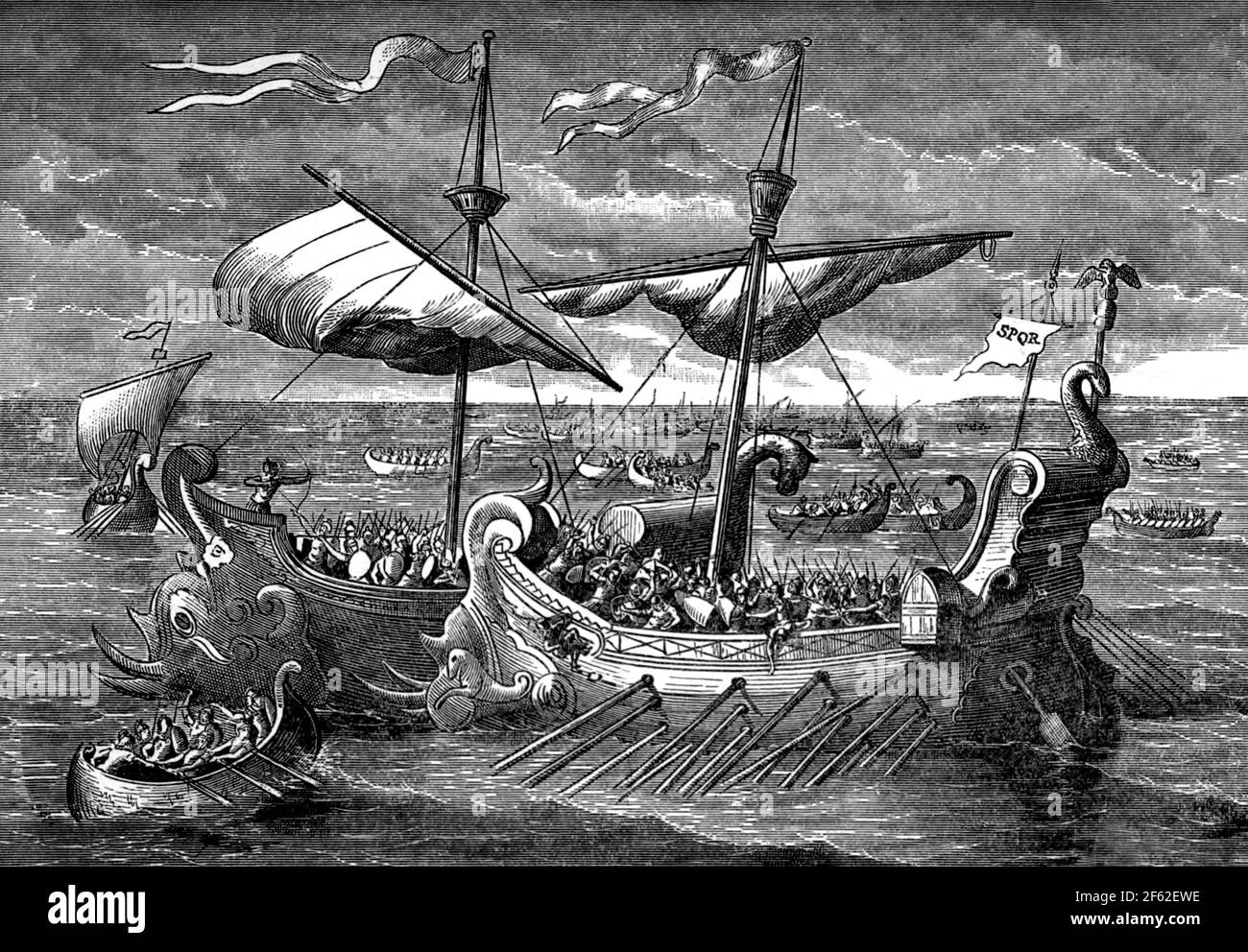Greek naval battle Black & White Stock Photos
 Battle of Salamis, 480 BC Stock Photohttps://www.alamy.com/image-license-details/?v=1https://www.alamy.com/battle-of-salamis-480-bc-image352785654.html
Battle of Salamis, 480 BC Stock Photohttps://www.alamy.com/image-license-details/?v=1https://www.alamy.com/battle-of-salamis-480-bc-image352785654.htmlRF2BDXNKJ–Battle of Salamis, 480 BC
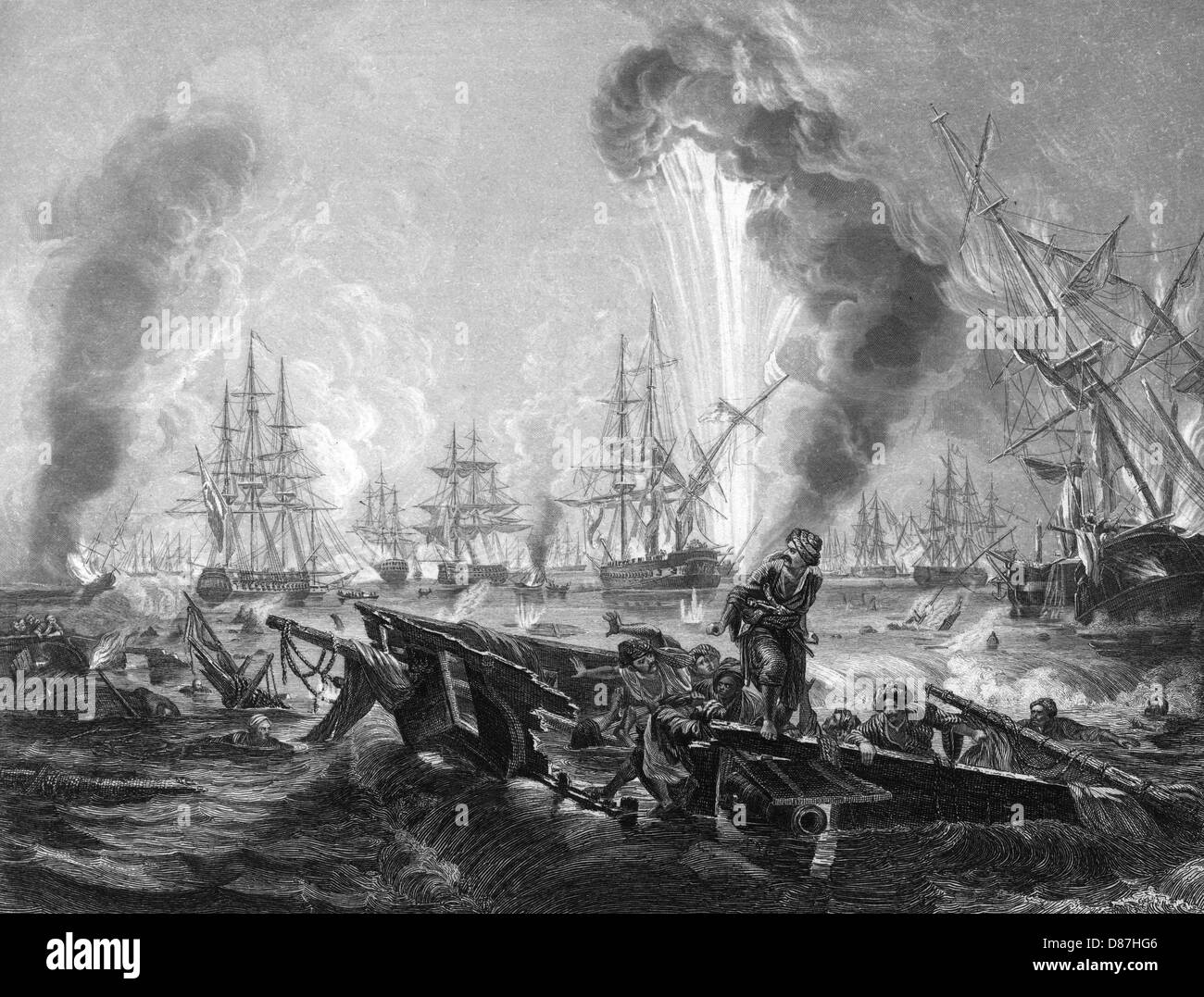 Battle Of Navarino 1827 Stock Photohttps://www.alamy.com/image-license-details/?v=1https://www.alamy.com/stock-photo-battle-of-navarino-1827-56715798.html
Battle Of Navarino 1827 Stock Photohttps://www.alamy.com/image-license-details/?v=1https://www.alamy.com/stock-photo-battle-of-navarino-1827-56715798.htmlRMD87HG6–Battle Of Navarino 1827
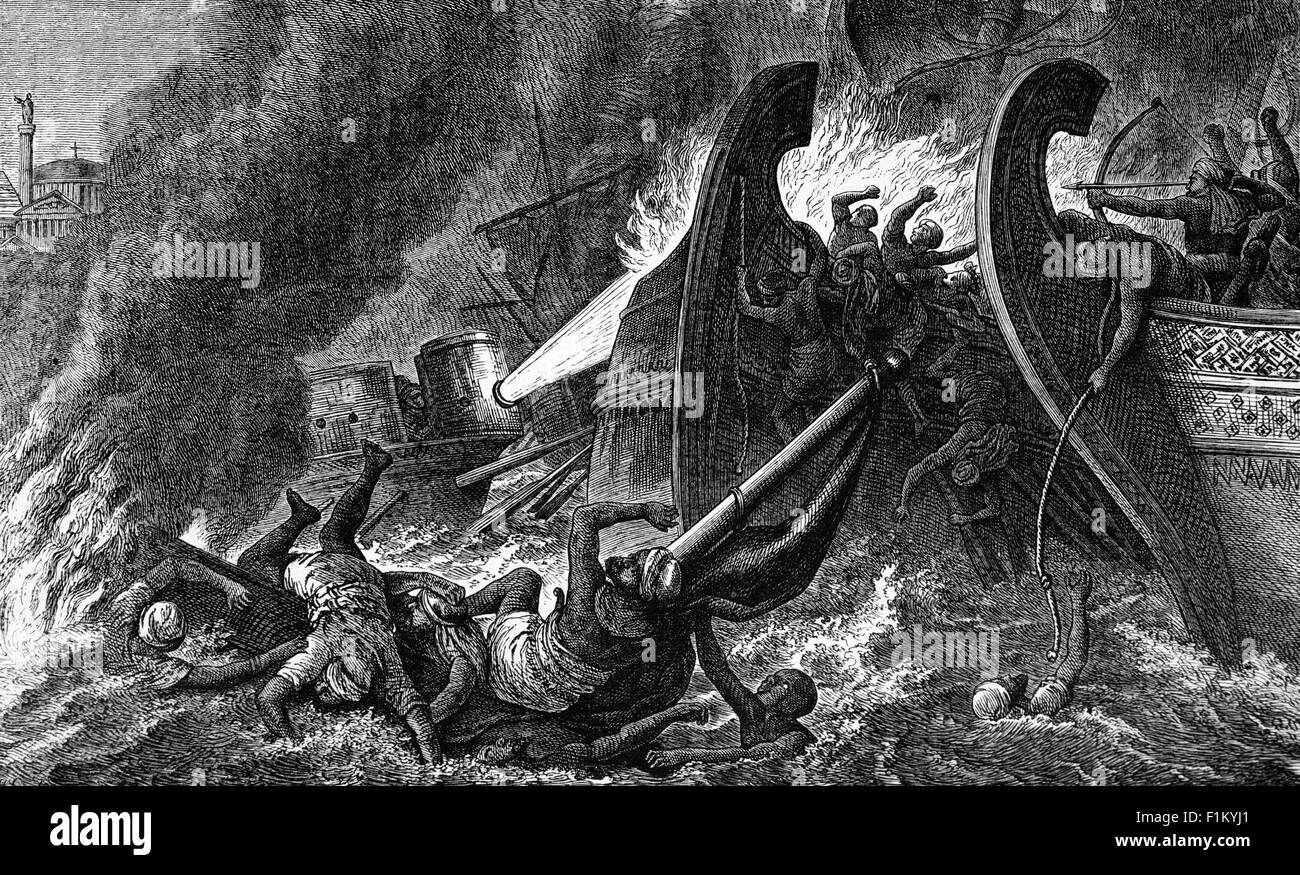 Ships destroyed by 'Greek Fire', an incendiary weapon used by the Byzantine Empire beginning c. 672. It consisted of a combustible compound probably based on naphtha and quicklime emitted by a flame-throwing weapon. The Byzantines typically used it in naval battles to great effect, as it could supposedly continue burning while floating on water. The technological advantage it provided was responsible for many key Byzantine military victories, most notably the salvation of Constantinople from the first and second Arab sieges, thus securing the Empire's survival. Stock Photohttps://www.alamy.com/image-license-details/?v=1https://www.alamy.com/stock-photo-ships-destroyed-by-greek-fire-an-incendiary-weapon-used-by-the-byzantine-87105257.html
Ships destroyed by 'Greek Fire', an incendiary weapon used by the Byzantine Empire beginning c. 672. It consisted of a combustible compound probably based on naphtha and quicklime emitted by a flame-throwing weapon. The Byzantines typically used it in naval battles to great effect, as it could supposedly continue burning while floating on water. The technological advantage it provided was responsible for many key Byzantine military victories, most notably the salvation of Constantinople from the first and second Arab sieges, thus securing the Empire's survival. Stock Photohttps://www.alamy.com/image-license-details/?v=1https://www.alamy.com/stock-photo-ships-destroyed-by-greek-fire-an-incendiary-weapon-used-by-the-byzantine-87105257.htmlRMF1KYJ1–Ships destroyed by 'Greek Fire', an incendiary weapon used by the Byzantine Empire beginning c. 672. It consisted of a combustible compound probably based on naphtha and quicklime emitted by a flame-throwing weapon. The Byzantines typically used it in naval battles to great effect, as it could supposedly continue burning while floating on water. The technological advantage it provided was responsible for many key Byzantine military victories, most notably the salvation of Constantinople from the first and second Arab sieges, thus securing the Empire's survival.
![Battle-scarred Greek warship at Southampton for Coronation review. The Greek battle-cruiser which is to take part in the Coronation naval review at Spithead, docked at Southampton. She survived intense aerial bombardment during the Greek revolution two years ago. Photo shows: Averoff [Georgios Averof] docking at Southampton. 7 May 1937 Stock Photo Battle-scarred Greek warship at Southampton for Coronation review. The Greek battle-cruiser which is to take part in the Coronation naval review at Spithead, docked at Southampton. She survived intense aerial bombardment during the Greek revolution two years ago. Photo shows: Averoff [Georgios Averof] docking at Southampton. 7 May 1937 Stock Photo](https://c8.alamy.com/comp/2BW1XNM/battle-scarred-greek-warship-at-southampton-for-coronation-review-the-greek-battle-cruiser-which-is-to-take-part-in-the-coronation-naval-review-at-spithead-docked-at-southampton-she-survived-intense-aerial-bombardment-during-the-greek-revolution-two-years-ago-photo-shows-averoff-georgios-averof-docking-at-southampton-7-may-1937-2BW1XNM.jpg) Battle-scarred Greek warship at Southampton for Coronation review. The Greek battle-cruiser which is to take part in the Coronation naval review at Spithead, docked at Southampton. She survived intense aerial bombardment during the Greek revolution two years ago. Photo shows: Averoff [Georgios Averof] docking at Southampton. 7 May 1937 Stock Photohttps://www.alamy.com/image-license-details/?v=1https://www.alamy.com/battle-scarred-greek-warship-at-southampton-for-coronation-review-the-greek-battle-cruiser-which-is-to-take-part-in-the-coronation-naval-review-at-spithead-docked-at-southampton-she-survived-intense-aerial-bombardment-during-the-greek-revolution-two-years-ago-photo-shows-averoff-georgios-averof-docking-at-southampton-7-may-1937-image359616704.html
Battle-scarred Greek warship at Southampton for Coronation review. The Greek battle-cruiser which is to take part in the Coronation naval review at Spithead, docked at Southampton. She survived intense aerial bombardment during the Greek revolution two years ago. Photo shows: Averoff [Georgios Averof] docking at Southampton. 7 May 1937 Stock Photohttps://www.alamy.com/image-license-details/?v=1https://www.alamy.com/battle-scarred-greek-warship-at-southampton-for-coronation-review-the-greek-battle-cruiser-which-is-to-take-part-in-the-coronation-naval-review-at-spithead-docked-at-southampton-she-survived-intense-aerial-bombardment-during-the-greek-revolution-two-years-ago-photo-shows-averoff-georgios-averof-docking-at-southampton-7-may-1937-image359616704.htmlRM2BW1XNM–Battle-scarred Greek warship at Southampton for Coronation review. The Greek battle-cruiser which is to take part in the Coronation naval review at Spithead, docked at Southampton. She survived intense aerial bombardment during the Greek revolution two years ago. Photo shows: Averoff [Georgios Averof] docking at Southampton. 7 May 1937
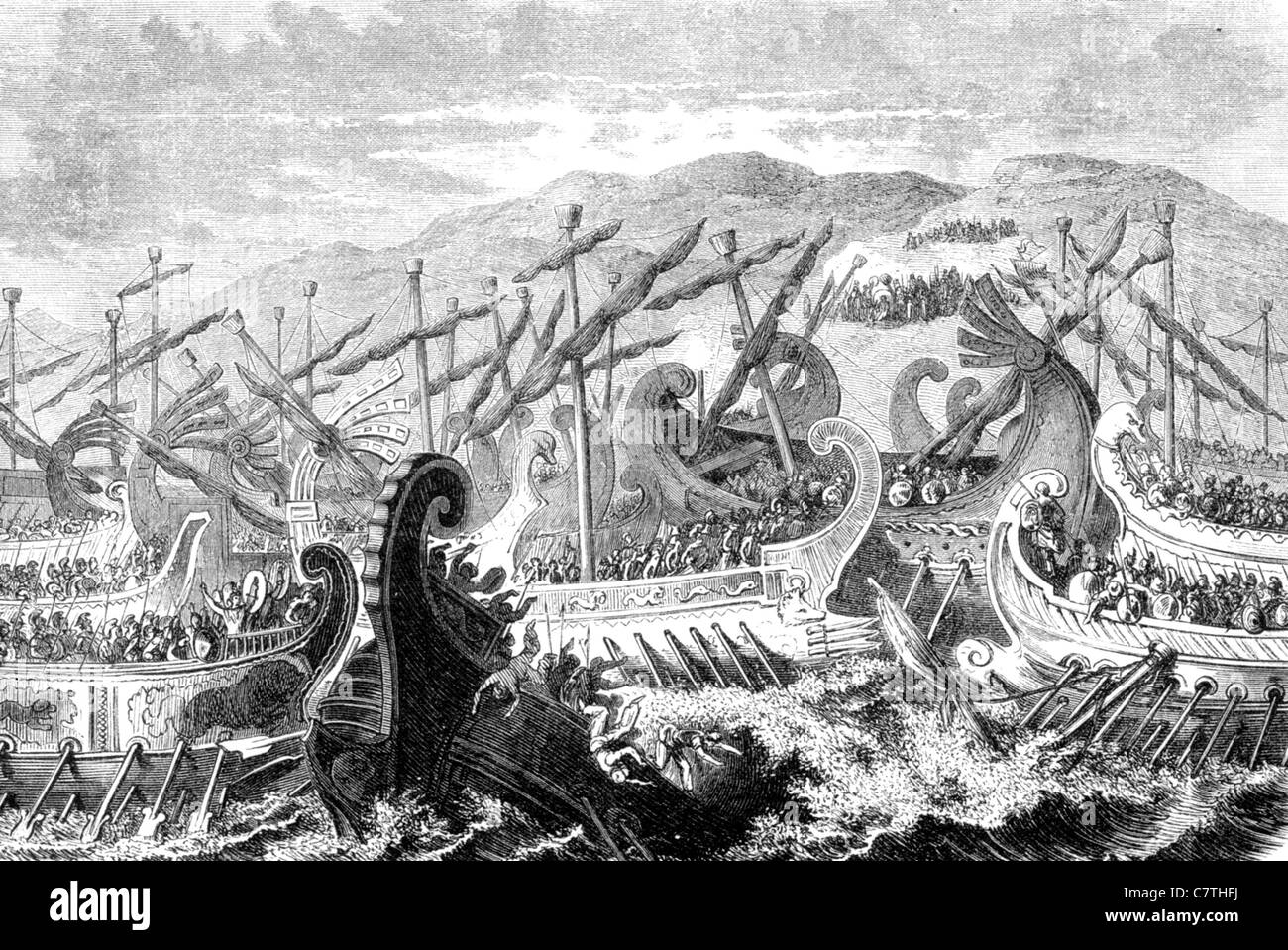 BATTLE OF SALAMIS September 480 BC between Greek City States and the Persian Empire as shown in an 18th century engraving Stock Photohttps://www.alamy.com/image-license-details/?v=1https://www.alamy.com/stock-photo-battle-of-salamis-september-480-bc-between-greek-city-states-and-the-39263942.html
BATTLE OF SALAMIS September 480 BC between Greek City States and the Persian Empire as shown in an 18th century engraving Stock Photohttps://www.alamy.com/image-license-details/?v=1https://www.alamy.com/stock-photo-battle-of-salamis-september-480-bc-between-greek-city-states-and-the-39263942.htmlRMC7THFJ–BATTLE OF SALAMIS September 480 BC between Greek City States and the Persian Empire as shown in an 18th century engraving
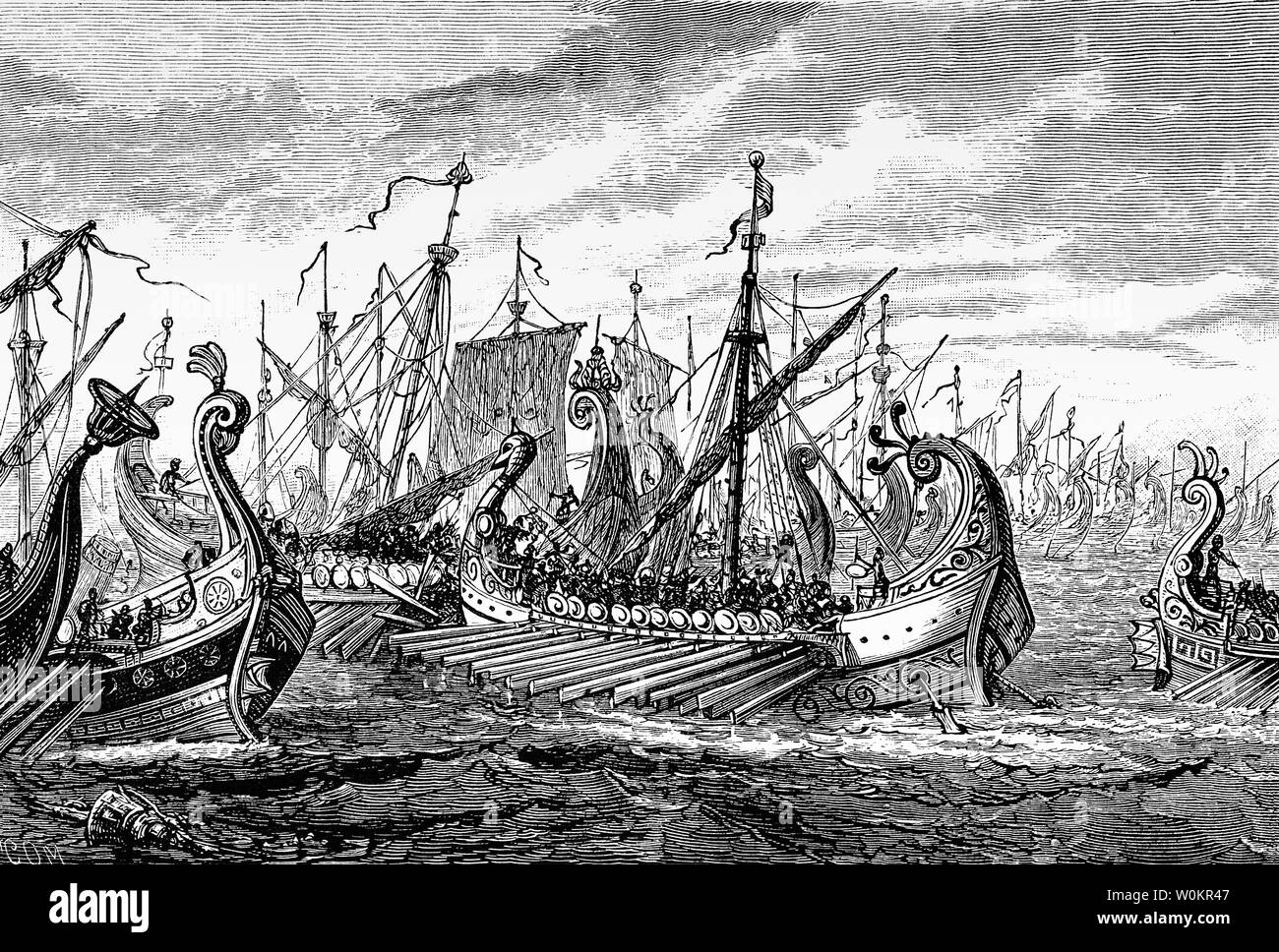 The naval Battle of Salamis fought in the straits between the mainland and Salamis, an island in the Saronic Gulf near Piraeus. The battle marked the high-point of the second Persian invasion of Greece was fought between an alliance of Greek city-states under Themistocles and the Persian Empire under King Xerxes in 480 BC and resulted in a decisive victory for the outnumbered Greeks. Stock Photohttps://www.alamy.com/image-license-details/?v=1https://www.alamy.com/the-naval-battle-of-salamis-fought-in-the-straits-between-the-mainland-and-salamis-an-island-in-the-saronic-gulf-near-piraeus-the-battle-marked-the-high-point-of-the-second-persian-invasion-of-greece-was-fought-between-an-alliance-of-greek-city-states-under-themistocles-and-the-persian-empire-under-king-xerxes-in-480-bc-and-resulted-in-a-decisive-victory-for-the-outnumbered-greeks-image258590759.html
The naval Battle of Salamis fought in the straits between the mainland and Salamis, an island in the Saronic Gulf near Piraeus. The battle marked the high-point of the second Persian invasion of Greece was fought between an alliance of Greek city-states under Themistocles and the Persian Empire under King Xerxes in 480 BC and resulted in a decisive victory for the outnumbered Greeks. Stock Photohttps://www.alamy.com/image-license-details/?v=1https://www.alamy.com/the-naval-battle-of-salamis-fought-in-the-straits-between-the-mainland-and-salamis-an-island-in-the-saronic-gulf-near-piraeus-the-battle-marked-the-high-point-of-the-second-persian-invasion-of-greece-was-fought-between-an-alliance-of-greek-city-states-under-themistocles-and-the-persian-empire-under-king-xerxes-in-480-bc-and-resulted-in-a-decisive-victory-for-the-outnumbered-greeks-image258590759.htmlRMW0KR47–The naval Battle of Salamis fought in the straits between the mainland and Salamis, an island in the Saronic Gulf near Piraeus. The battle marked the high-point of the second Persian invasion of Greece was fought between an alliance of Greek city-states under Themistocles and the Persian Empire under King Xerxes in 480 BC and resulted in a decisive victory for the outnumbered Greeks.
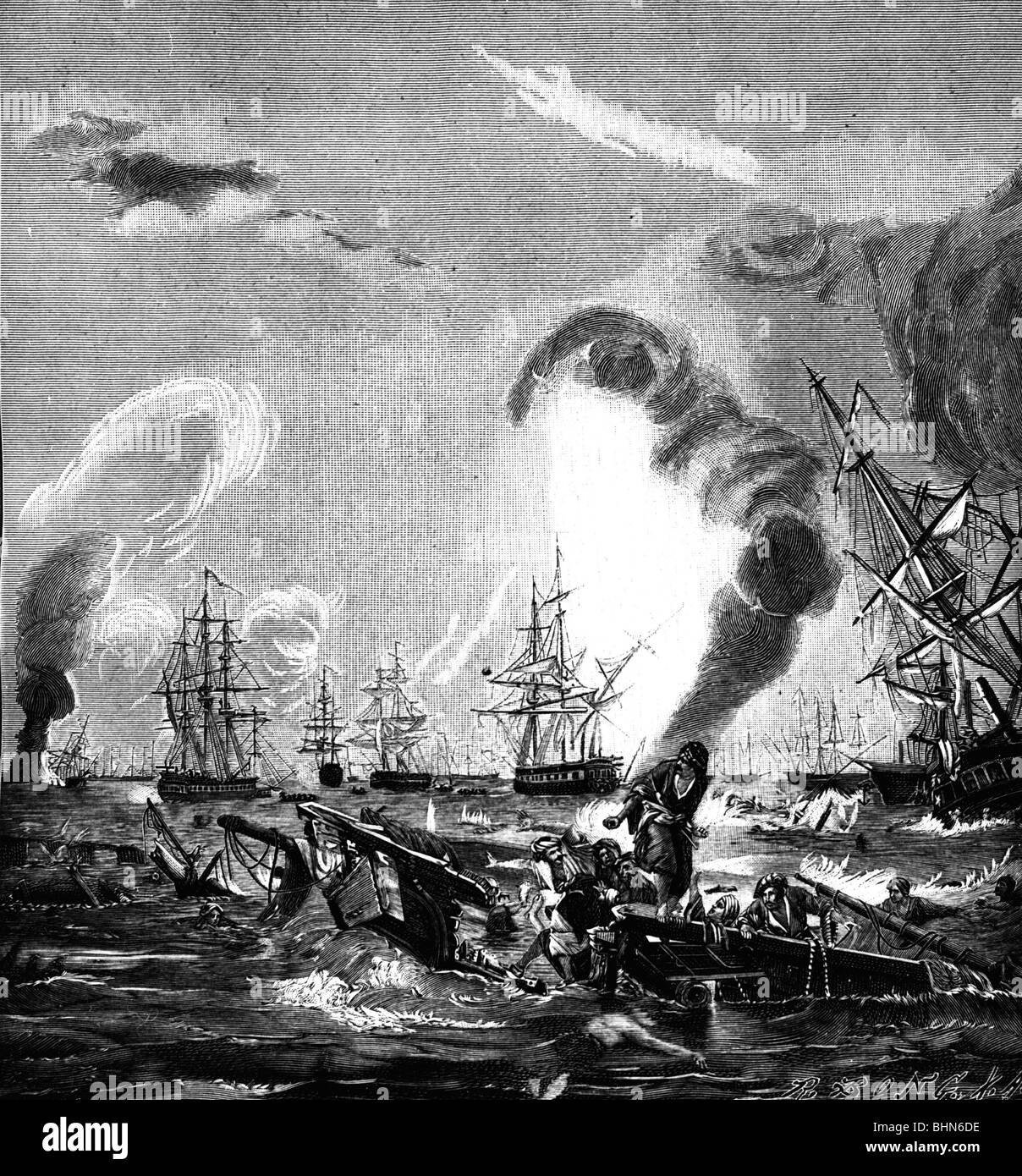 events, Greek War of Independence, 1821 - 1829, Battle of Navarino, 10.10.1827, wood engraving after painting by Ch. Langlois, 19th century, Greece, Ionian Sea, French, Russian, British Royal Navy, Ottoman Empire, Turkish, Egyptioan, Fleet, naval, ear ships, historic, historical, people, Stock Photohttps://www.alamy.com/image-license-details/?v=1https://www.alamy.com/stock-photo-events-greek-war-of-independence-1821-1829-battle-of-navarino-10101827-28125594.html
events, Greek War of Independence, 1821 - 1829, Battle of Navarino, 10.10.1827, wood engraving after painting by Ch. Langlois, 19th century, Greece, Ionian Sea, French, Russian, British Royal Navy, Ottoman Empire, Turkish, Egyptioan, Fleet, naval, ear ships, historic, historical, people, Stock Photohttps://www.alamy.com/image-license-details/?v=1https://www.alamy.com/stock-photo-events-greek-war-of-independence-1821-1829-battle-of-navarino-10101827-28125594.htmlRMBHN6DE–events, Greek War of Independence, 1821 - 1829, Battle of Navarino, 10.10.1827, wood engraving after painting by Ch. Langlois, 19th century, Greece, Ionian Sea, French, Russian, British Royal Navy, Ottoman Empire, Turkish, Egyptioan, Fleet, naval, ear ships, historic, historical, people,
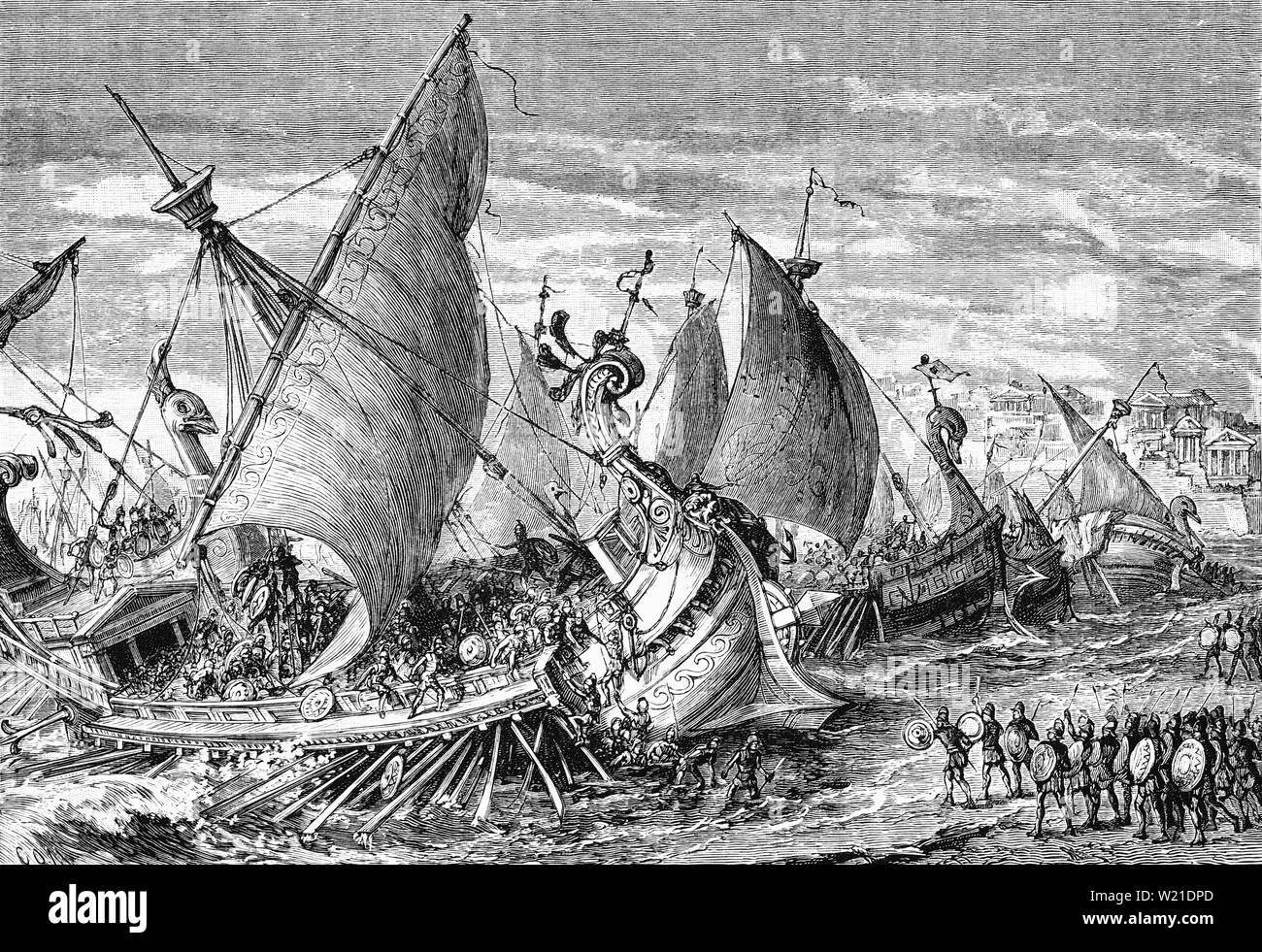 Following the largest single Athenian expedition in the Peloponnesian War, a final sea battle consisting of many triremes, took place in the Great Harbour at Syracuse in Sicily, part of the Greek Empire (Magna Graecia) in 413 BCe. The first impetus of the Athenian attack carried them through the Syracusan vessels guarding the boom across the harbour mouth. The Athenians began loosening the chained merchantmen, but other Syracusan warships appeared from all directions and the fighting spread throughout the harbour, from which Syracuse and Sparta Athens and its allies emerged victorious Stock Photohttps://www.alamy.com/image-license-details/?v=1https://www.alamy.com/following-the-largest-single-athenian-expedition-in-the-peloponnesian-war-a-final-sea-battle-consisting-of-many-triremes-took-place-in-the-great-harbour-at-syracuse-in-sicily-part-of-the-greek-empire-magna-graecia-in-413-bce-the-first-impetus-of-the-athenian-attack-carried-them-through-the-syracusan-vessels-guarding-the-boom-across-the-harbour-mouth-the-athenians-began-loosening-the-chained-merchantmen-but-other-syracusan-warships-appeared-from-all-directions-and-the-fighting-spread-throughout-the-harbour-from-which-syracuse-and-sparta-athens-and-its-allies-emerged-victorious-image259417605.html
Following the largest single Athenian expedition in the Peloponnesian War, a final sea battle consisting of many triremes, took place in the Great Harbour at Syracuse in Sicily, part of the Greek Empire (Magna Graecia) in 413 BCe. The first impetus of the Athenian attack carried them through the Syracusan vessels guarding the boom across the harbour mouth. The Athenians began loosening the chained merchantmen, but other Syracusan warships appeared from all directions and the fighting spread throughout the harbour, from which Syracuse and Sparta Athens and its allies emerged victorious Stock Photohttps://www.alamy.com/image-license-details/?v=1https://www.alamy.com/following-the-largest-single-athenian-expedition-in-the-peloponnesian-war-a-final-sea-battle-consisting-of-many-triremes-took-place-in-the-great-harbour-at-syracuse-in-sicily-part-of-the-greek-empire-magna-graecia-in-413-bce-the-first-impetus-of-the-athenian-attack-carried-them-through-the-syracusan-vessels-guarding-the-boom-across-the-harbour-mouth-the-athenians-began-loosening-the-chained-merchantmen-but-other-syracusan-warships-appeared-from-all-directions-and-the-fighting-spread-throughout-the-harbour-from-which-syracuse-and-sparta-athens-and-its-allies-emerged-victorious-image259417605.htmlRMW21DPD–Following the largest single Athenian expedition in the Peloponnesian War, a final sea battle consisting of many triremes, took place in the Great Harbour at Syracuse in Sicily, part of the Greek Empire (Magna Graecia) in 413 BCe. The first impetus of the Athenian attack carried them through the Syracusan vessels guarding the boom across the harbour mouth. The Athenians began loosening the chained merchantmen, but other Syracusan warships appeared from all directions and the fighting spread throughout the harbour, from which Syracuse and Sparta Athens and its allies emerged victorious
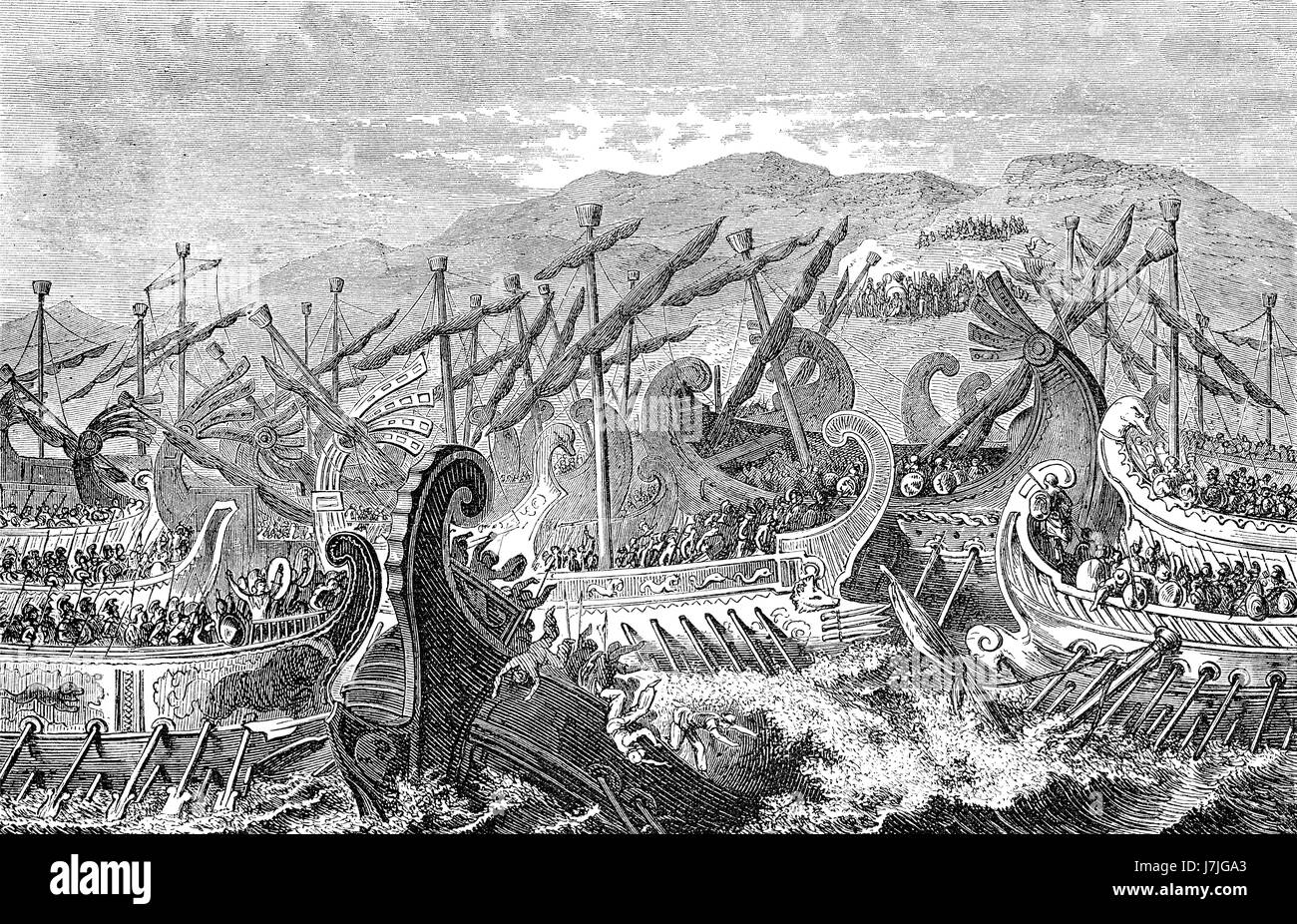 The Battle of Salamis in 480 BC fought between Greek city-states and the Persian Empire Stock Photohttps://www.alamy.com/image-license-details/?v=1https://www.alamy.com/stock-photo-the-battle-of-salamis-in-480-bc-fought-between-greek-city-states-and-142393499.html
The Battle of Salamis in 480 BC fought between Greek city-states and the Persian Empire Stock Photohttps://www.alamy.com/image-license-details/?v=1https://www.alamy.com/stock-photo-the-battle-of-salamis-in-480-bc-fought-between-greek-city-states-and-142393499.htmlRMJ7JGA3–The Battle of Salamis in 480 BC fought between Greek city-states and the Persian Empire
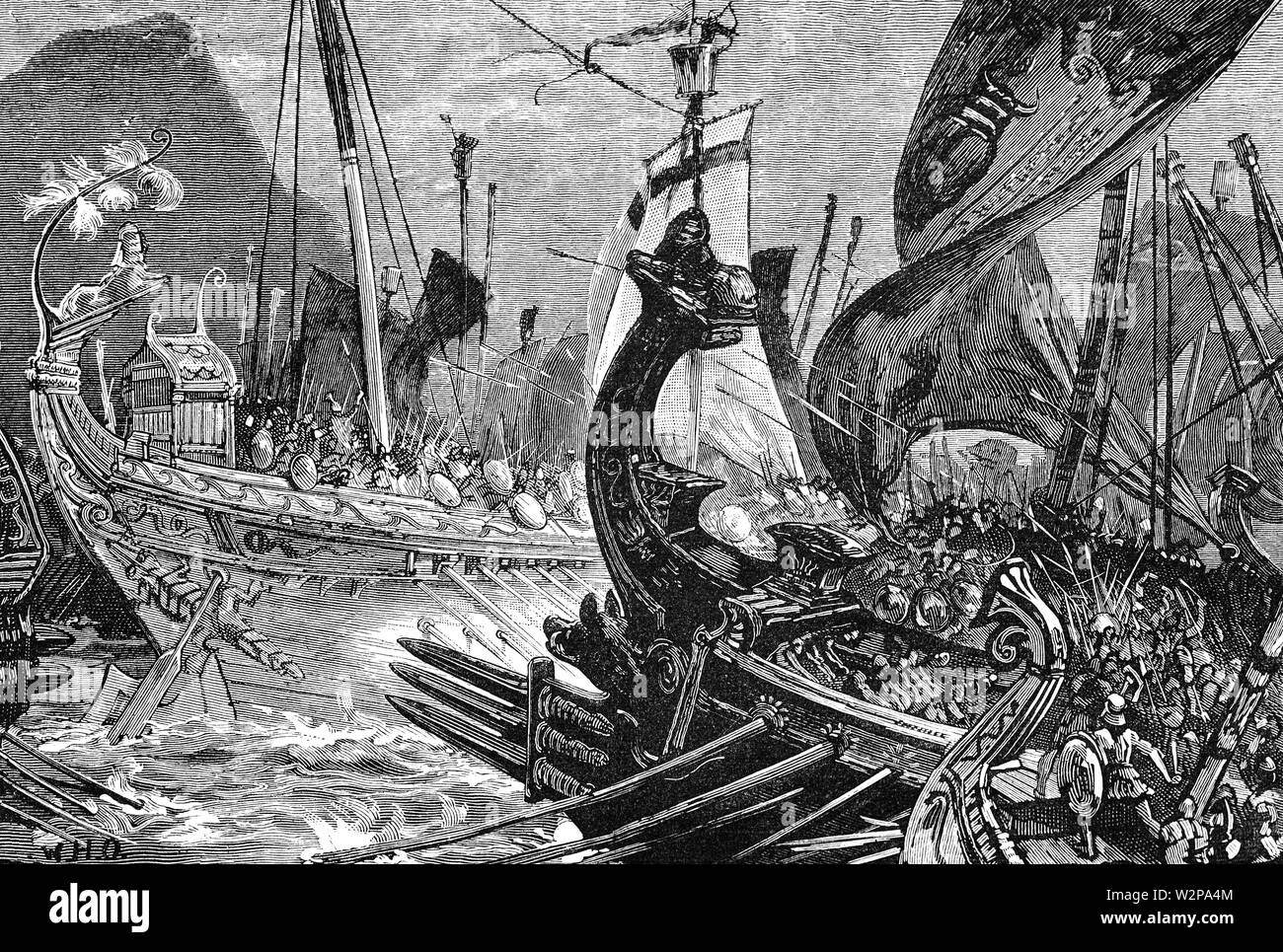 The naval Battle of Salamis in 306 BC took place off Salamis, Cyprus between the fleets of Ptolemy I (367 BC – 282 BC) a companion and historian of Alexander the Great of the Kingdom of Macedon in northern Greece who became ruler of Egypt and Demetrius I (337–283 BC), a Greek Macedonian nobleman, military leader, and finally king of Macedonia (294–288 BC). The battle was a complete victory for Demetrius, who destroyed or captured much of Ptolemy's fleet and army, and captured Cyprus. Stock Photohttps://www.alamy.com/image-license-details/?v=1https://www.alamy.com/the-naval-battle-of-salamis-in-306-bc-took-place-off-salamis-cyprus-between-the-fleets-of-ptolemy-i-367-bc-282-bc-a-companion-and-historian-of-alexander-the-great-of-the-kingdom-of-macedon-in-northern-greece-who-became-ruler-of-egypt-and-demetrius-i-337283-bc-a-greek-macedonian-nobleman-military-leader-and-finally-king-of-macedonia-294288-bc-the-battle-was-a-complete-victory-for-demetrius-who-destroyed-or-captured-much-of-ptolemys-fleet-and-army-and-captured-cyprus-image259875748.html
The naval Battle of Salamis in 306 BC took place off Salamis, Cyprus between the fleets of Ptolemy I (367 BC – 282 BC) a companion and historian of Alexander the Great of the Kingdom of Macedon in northern Greece who became ruler of Egypt and Demetrius I (337–283 BC), a Greek Macedonian nobleman, military leader, and finally king of Macedonia (294–288 BC). The battle was a complete victory for Demetrius, who destroyed or captured much of Ptolemy's fleet and army, and captured Cyprus. Stock Photohttps://www.alamy.com/image-license-details/?v=1https://www.alamy.com/the-naval-battle-of-salamis-in-306-bc-took-place-off-salamis-cyprus-between-the-fleets-of-ptolemy-i-367-bc-282-bc-a-companion-and-historian-of-alexander-the-great-of-the-kingdom-of-macedon-in-northern-greece-who-became-ruler-of-egypt-and-demetrius-i-337283-bc-a-greek-macedonian-nobleman-military-leader-and-finally-king-of-macedonia-294288-bc-the-battle-was-a-complete-victory-for-demetrius-who-destroyed-or-captured-much-of-ptolemys-fleet-and-army-and-captured-cyprus-image259875748.htmlRMW2PA4M–The naval Battle of Salamis in 306 BC took place off Salamis, Cyprus between the fleets of Ptolemy I (367 BC – 282 BC) a companion and historian of Alexander the Great of the Kingdom of Macedon in northern Greece who became ruler of Egypt and Demetrius I (337–283 BC), a Greek Macedonian nobleman, military leader, and finally king of Macedonia (294–288 BC). The battle was a complete victory for Demetrius, who destroyed or captured much of Ptolemy's fleet and army, and captured Cyprus.
 Greeks Return from Battle of Salamis, 480 BC Stock Photohttps://www.alamy.com/image-license-details/?v=1https://www.alamy.com/greeks-return-from-battle-of-salamis-480-bc-image386298670.html
Greeks Return from Battle of Salamis, 480 BC Stock Photohttps://www.alamy.com/image-license-details/?v=1https://www.alamy.com/greeks-return-from-battle-of-salamis-480-bc-image386298670.htmlRF2DCDBW2–Greeks Return from Battle of Salamis, 480 BC
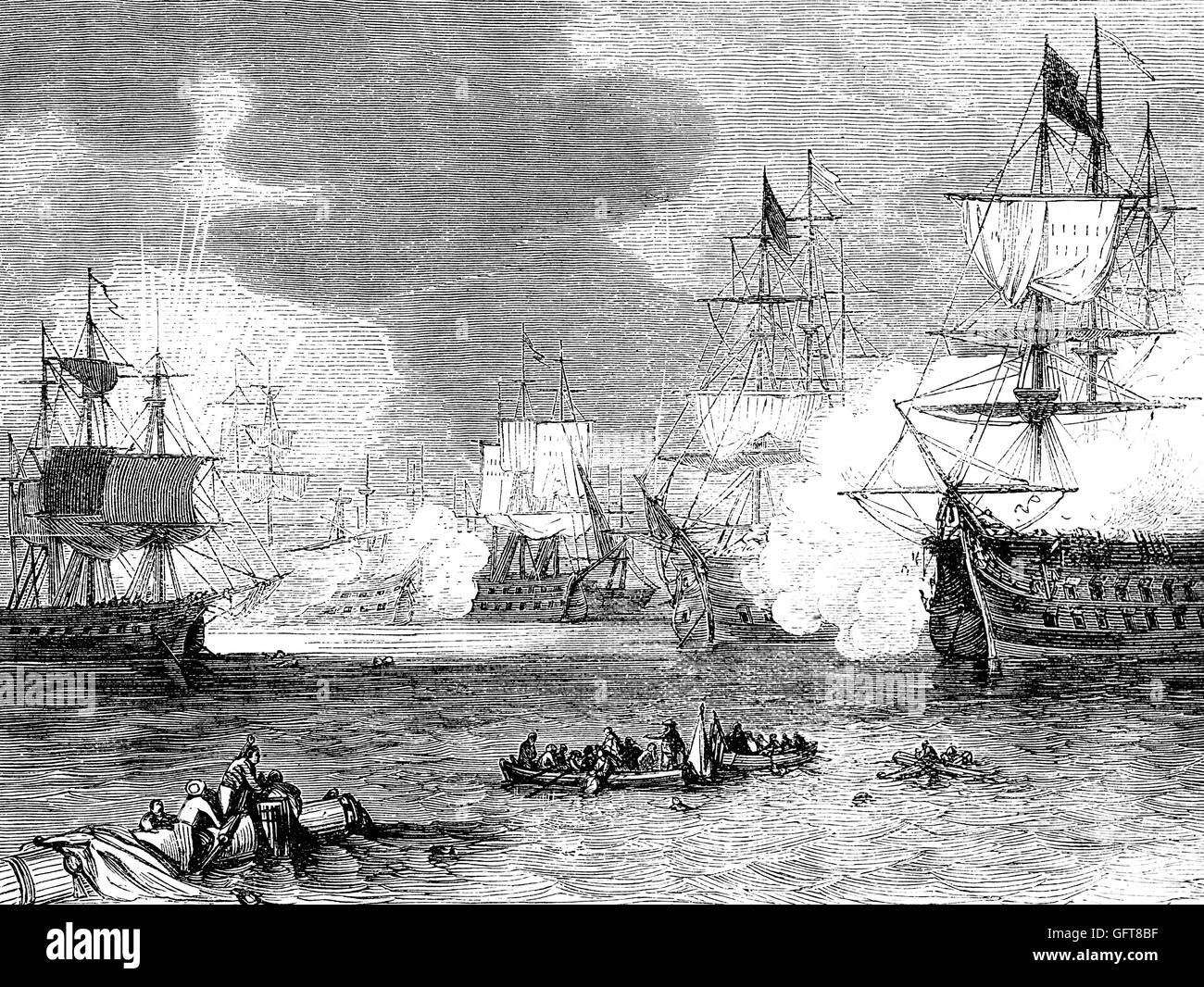 The Battle of Navarino fought on 20 October 1827, during the Greek War of Independence in Navarino Bay (modern-day Pylos), on the west coast of the Peloponnese peninsula, in the Ionian Sea. An Allied force of British, French and Russian vessels defeated an Ottoman armada of warships, Egypt, Tunis and Algiers. It was the last major naval battle in history to be fought entirely with sailing ships Stock Photohttps://www.alamy.com/image-license-details/?v=1https://www.alamy.com/stock-photo-the-battle-of-navarino-fought-on-20-october-1827-during-the-greek-113015491.html
The Battle of Navarino fought on 20 October 1827, during the Greek War of Independence in Navarino Bay (modern-day Pylos), on the west coast of the Peloponnese peninsula, in the Ionian Sea. An Allied force of British, French and Russian vessels defeated an Ottoman armada of warships, Egypt, Tunis and Algiers. It was the last major naval battle in history to be fought entirely with sailing ships Stock Photohttps://www.alamy.com/image-license-details/?v=1https://www.alamy.com/stock-photo-the-battle-of-navarino-fought-on-20-october-1827-during-the-greek-113015491.htmlRMGFT8BF–The Battle of Navarino fought on 20 October 1827, during the Greek War of Independence in Navarino Bay (modern-day Pylos), on the west coast of the Peloponnese peninsula, in the Ionian Sea. An Allied force of British, French and Russian vessels defeated an Ottoman armada of warships, Egypt, Tunis and Algiers. It was the last major naval battle in history to be fought entirely with sailing ships
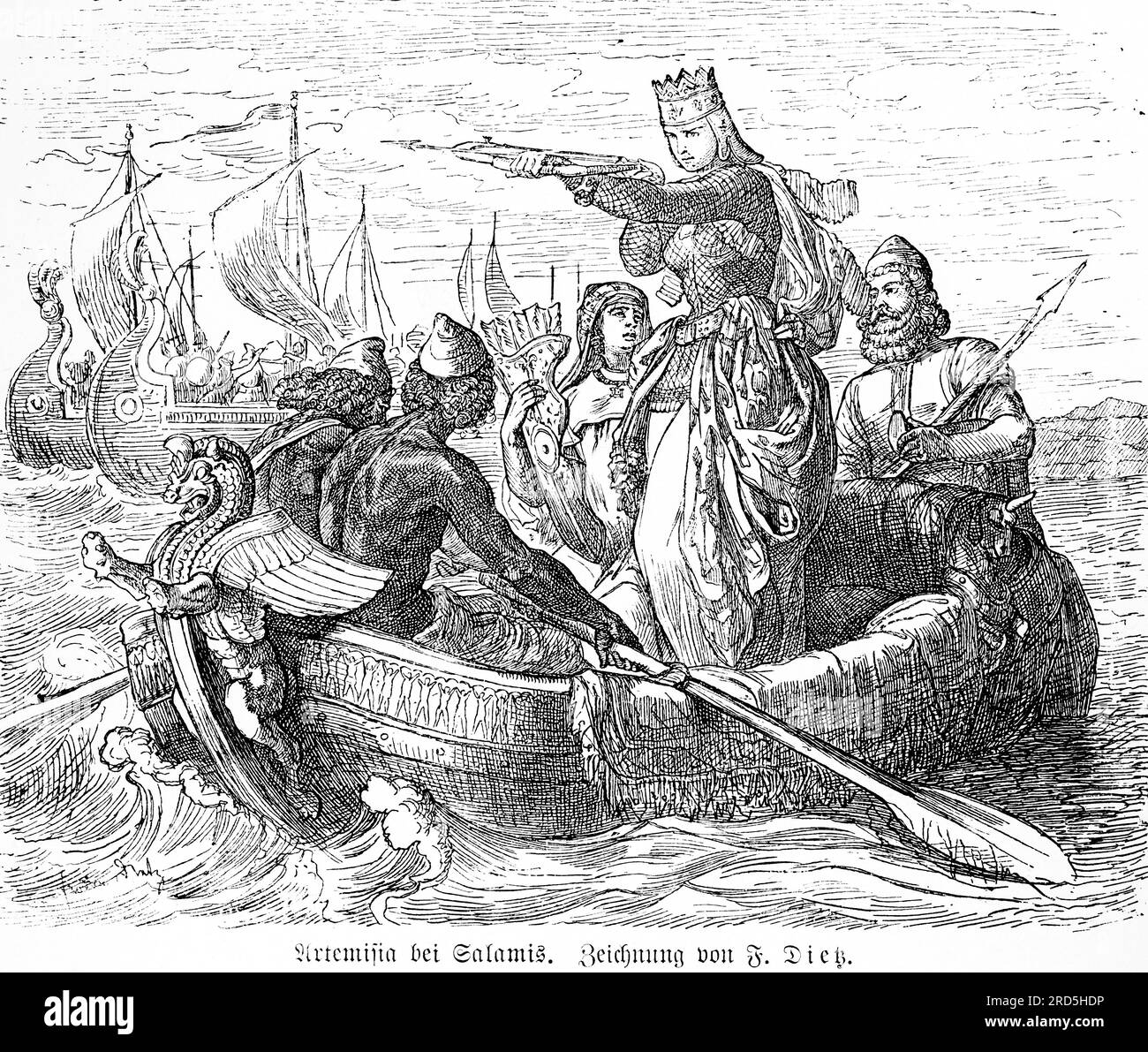 Queen Artemisia in the naval battle of Salamis, ancient Greece, heroine, Persians, Greeks, warships, sailing ships, sea, boat, crossbow, shooting Stock Photohttps://www.alamy.com/image-license-details/?v=1https://www.alamy.com/queen-artemisia-in-the-naval-battle-of-salamis-ancient-greece-heroine-persians-greeks-warships-sailing-ships-sea-boat-crossbow-shooting-image558845778.html
Queen Artemisia in the naval battle of Salamis, ancient Greece, heroine, Persians, Greeks, warships, sailing ships, sea, boat, crossbow, shooting Stock Photohttps://www.alamy.com/image-license-details/?v=1https://www.alamy.com/queen-artemisia-in-the-naval-battle-of-salamis-ancient-greece-heroine-persians-greeks-warships-sailing-ships-sea-boat-crossbow-shooting-image558845778.htmlRM2RD5HDP–Queen Artemisia in the naval battle of Salamis, ancient Greece, heroine, Persians, Greeks, warships, sailing ships, sea, boat, crossbow, shooting
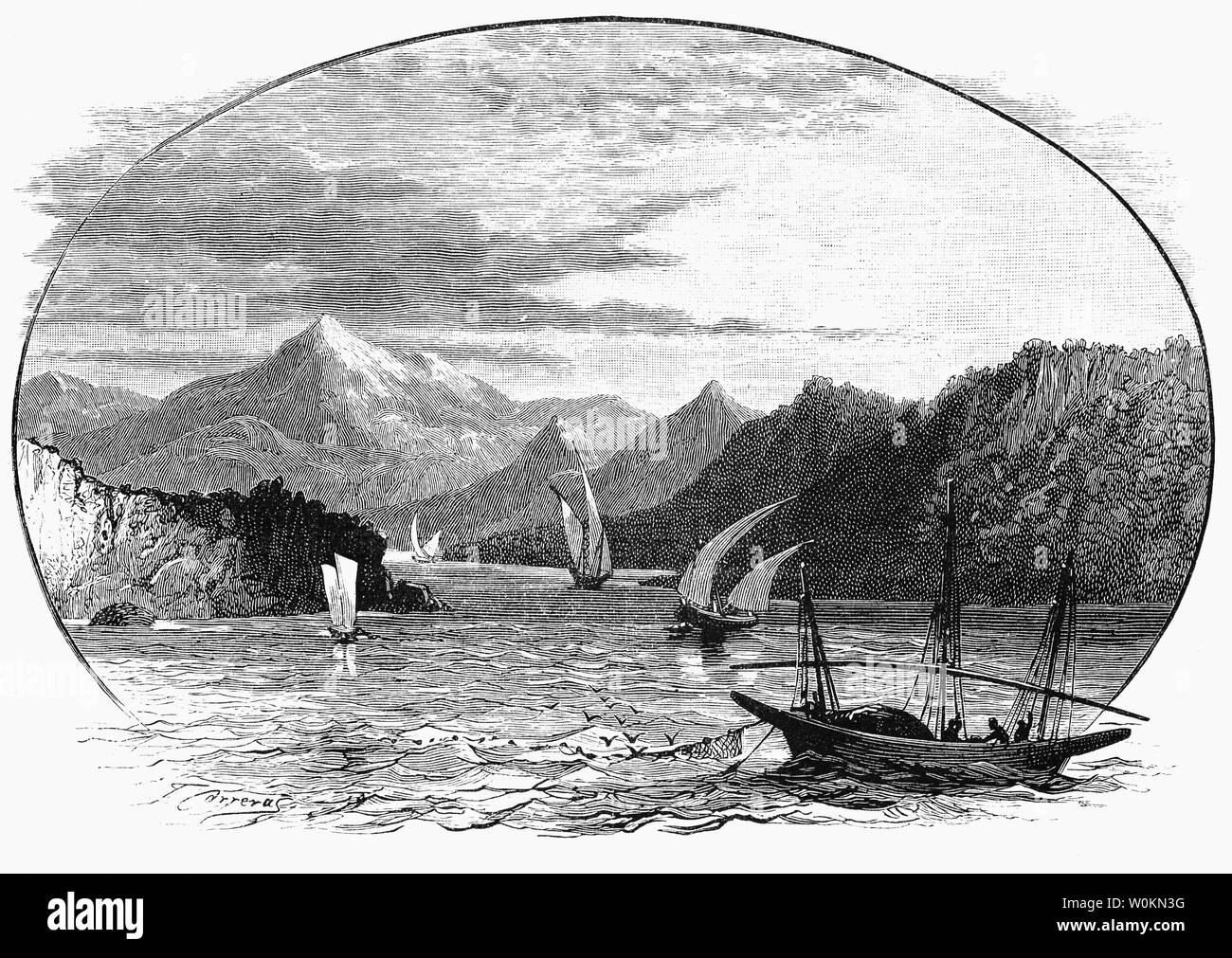 A 19th Century view of the site of the naval Battle of Salamis fought in the straits between the mainland and Salamis, an island in the Saronic Gulf near Piraeus. The battle marked the high-point of the second Persian invasion of Greece was fought between an alliance of Greek city-states under Themistocles and the Persian Empire under King Xerxes I in 480 BC and resulted in a decisive victory for the outnumbered Greeks Stock Photohttps://www.alamy.com/image-license-details/?v=1https://www.alamy.com/a-19th-century-view-of-the-site-of-the-naval-battle-of-salamis-fought-in-the-straits-between-the-mainland-and-salamis-an-island-in-the-saronic-gulf-near-piraeus-the-battle-marked-the-high-point-of-the-second-persian-invasion-of-greece-was-fought-between-an-alliance-of-greek-city-states-under-themistocles-and-the-persian-empire-under-king-xerxes-i-in-480-bc-and-resulted-in-a-decisive-victory-for-the-outnumbered-greeks-image258589172.html
A 19th Century view of the site of the naval Battle of Salamis fought in the straits between the mainland and Salamis, an island in the Saronic Gulf near Piraeus. The battle marked the high-point of the second Persian invasion of Greece was fought between an alliance of Greek city-states under Themistocles and the Persian Empire under King Xerxes I in 480 BC and resulted in a decisive victory for the outnumbered Greeks Stock Photohttps://www.alamy.com/image-license-details/?v=1https://www.alamy.com/a-19th-century-view-of-the-site-of-the-naval-battle-of-salamis-fought-in-the-straits-between-the-mainland-and-salamis-an-island-in-the-saronic-gulf-near-piraeus-the-battle-marked-the-high-point-of-the-second-persian-invasion-of-greece-was-fought-between-an-alliance-of-greek-city-states-under-themistocles-and-the-persian-empire-under-king-xerxes-i-in-480-bc-and-resulted-in-a-decisive-victory-for-the-outnumbered-greeks-image258589172.htmlRMW0KN3G–A 19th Century view of the site of the naval Battle of Salamis fought in the straits between the mainland and Salamis, an island in the Saronic Gulf near Piraeus. The battle marked the high-point of the second Persian invasion of Greece was fought between an alliance of Greek city-states under Themistocles and the Persian Empire under King Xerxes I in 480 BC and resulted in a decisive victory for the outnumbered Greeks
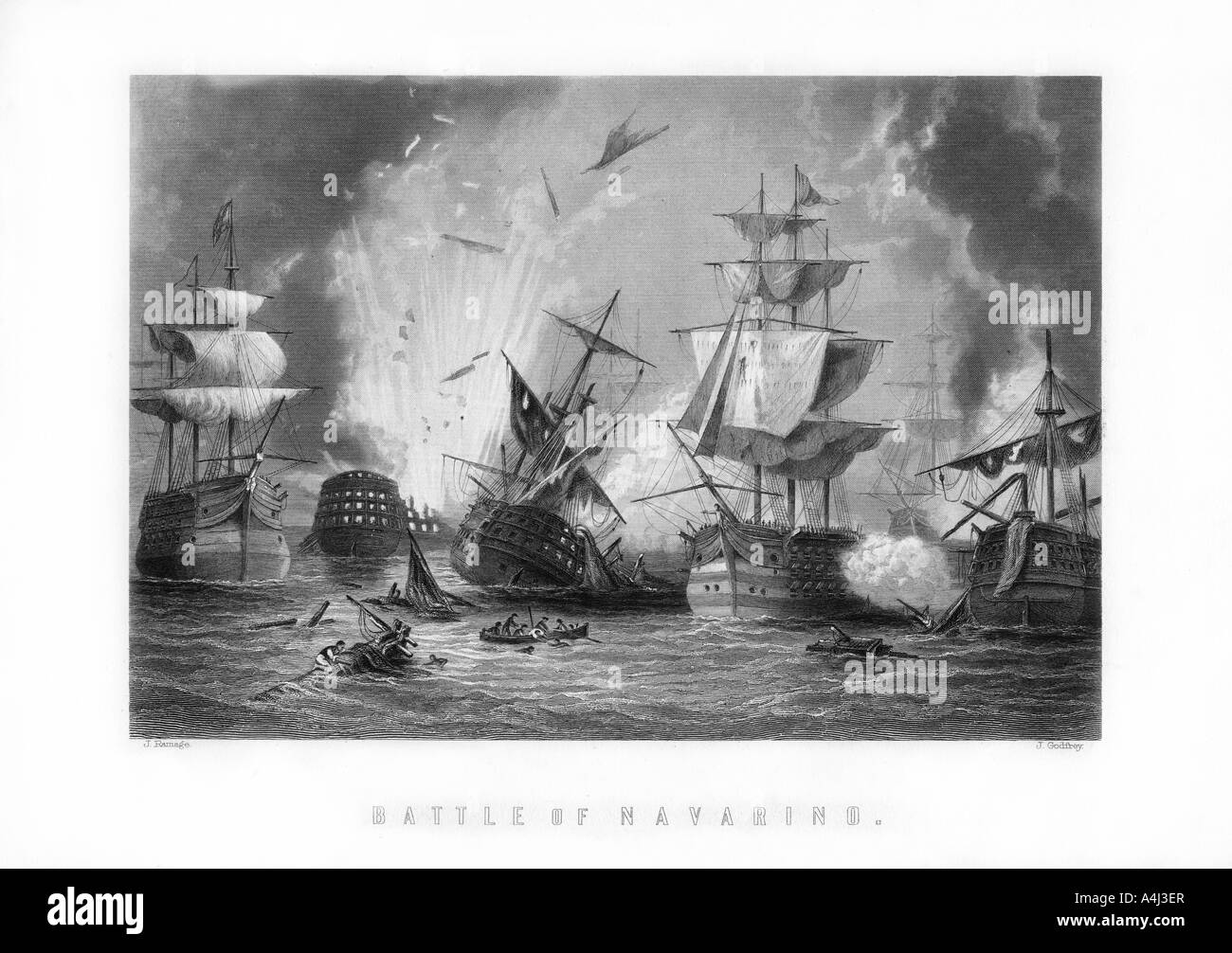 The naval Battle of Navarino, 20th October 1827, (1893).Artist: J Godfrey Stock Photohttps://www.alamy.com/image-license-details/?v=1https://www.alamy.com/stock-photo-the-naval-battle-of-navarino-20th-october-1827-1893artist-j-godfrey-11058718.html
The naval Battle of Navarino, 20th October 1827, (1893).Artist: J Godfrey Stock Photohttps://www.alamy.com/image-license-details/?v=1https://www.alamy.com/stock-photo-the-naval-battle-of-navarino-20th-october-1827-1893artist-j-godfrey-11058718.htmlRMA4J3ER–The naval Battle of Navarino, 20th October 1827, (1893).Artist: J Godfrey
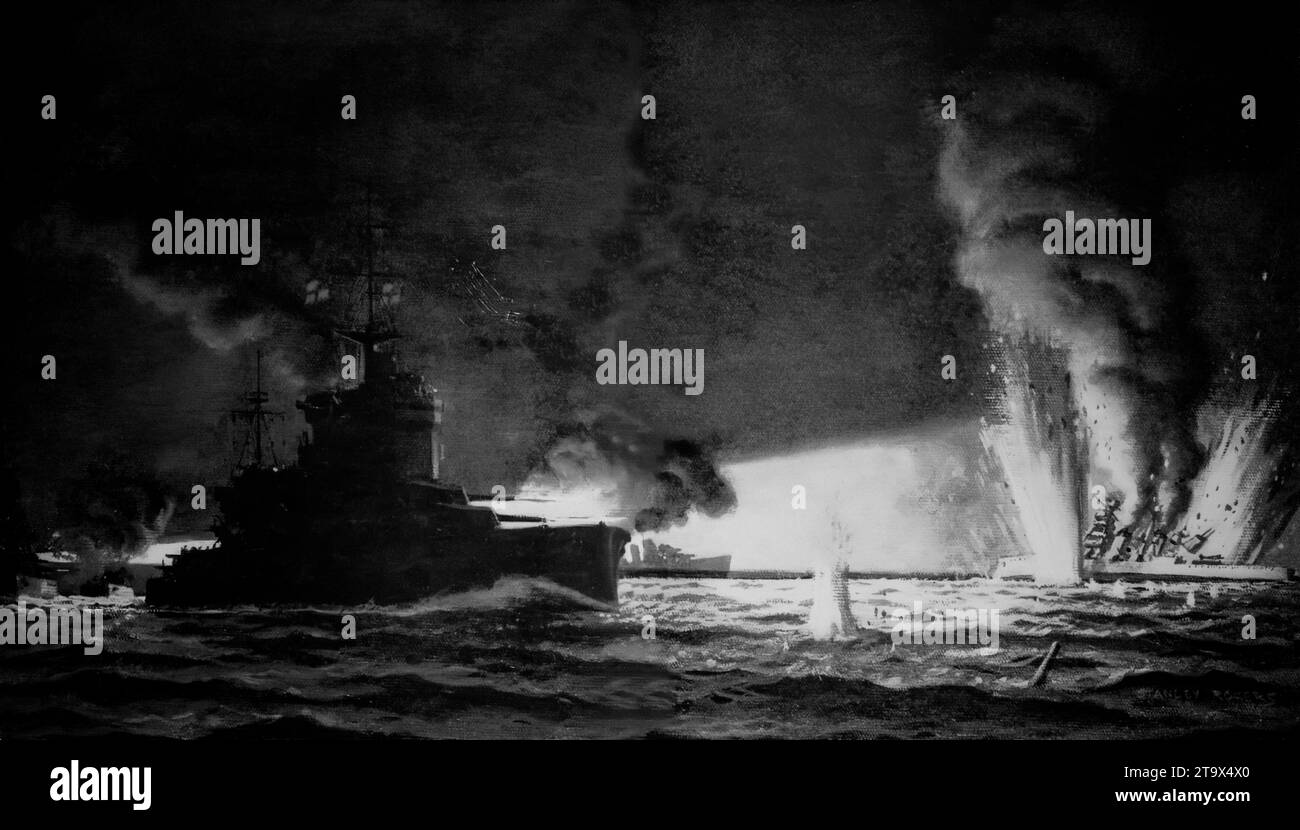 An illustration by Stanley Rogers of the Battle of Cape Matapan off the south-western coast of the Peloponnesian Peninsula of Greece, that took place on 23rd March 1941 in the Second World War. The illustration shows the British battleship and flagship 'Warspite' shelling the Italian heavy cruiser Fiume. The ship sank along with two other Italian cruisers, the Zara and Pola. Stock Photohttps://www.alamy.com/image-license-details/?v=1https://www.alamy.com/an-illustration-by-stanley-rogers-of-the-battle-of-cape-matapan-off-the-south-western-coast-of-the-peloponnesian-peninsula-of-greece-that-took-place-on-23rd-march-1941-in-the-second-world-war-the-illustration-shows-the-british-battleship-and-flagship-warspite-shelling-the-italian-heavy-cruiser-fiume-the-ship-sank-along-with-two-other-italian-cruisers-the-zara-and-pola-image574048664.html
An illustration by Stanley Rogers of the Battle of Cape Matapan off the south-western coast of the Peloponnesian Peninsula of Greece, that took place on 23rd March 1941 in the Second World War. The illustration shows the British battleship and flagship 'Warspite' shelling the Italian heavy cruiser Fiume. The ship sank along with two other Italian cruisers, the Zara and Pola. Stock Photohttps://www.alamy.com/image-license-details/?v=1https://www.alamy.com/an-illustration-by-stanley-rogers-of-the-battle-of-cape-matapan-off-the-south-western-coast-of-the-peloponnesian-peninsula-of-greece-that-took-place-on-23rd-march-1941-in-the-second-world-war-the-illustration-shows-the-british-battleship-and-flagship-warspite-shelling-the-italian-heavy-cruiser-fiume-the-ship-sank-along-with-two-other-italian-cruisers-the-zara-and-pola-image574048664.htmlRM2T9X4X0–An illustration by Stanley Rogers of the Battle of Cape Matapan off the south-western coast of the Peloponnesian Peninsula of Greece, that took place on 23rd March 1941 in the Second World War. The illustration shows the British battleship and flagship 'Warspite' shelling the Italian heavy cruiser Fiume. The ship sank along with two other Italian cruisers, the Zara and Pola.
 'Old Greek War Ships at the Battle of Salamis, 480BC', 1886. From "The Graphic. An Illustrated Weekly Newspaper Volume 33. January to June, 1886". Stock Photohttps://www.alamy.com/image-license-details/?v=1https://www.alamy.com/old-greek-war-ships-at-the-battle-of-salamis-480bc-1886-from-quotthe-graphic-an-illustrated-weekly-newspaper-volume-33-january-to-june-1886quot-image481976244.html
'Old Greek War Ships at the Battle of Salamis, 480BC', 1886. From "The Graphic. An Illustrated Weekly Newspaper Volume 33. January to June, 1886". Stock Photohttps://www.alamy.com/image-license-details/?v=1https://www.alamy.com/old-greek-war-ships-at-the-battle-of-salamis-480bc-1886-from-quotthe-graphic-an-illustrated-weekly-newspaper-volume-33-january-to-june-1886quot-image481976244.htmlRM2K03WH8–'Old Greek War Ships at the Battle of Salamis, 480BC', 1886. From "The Graphic. An Illustrated Weekly Newspaper Volume 33. January to June, 1886".
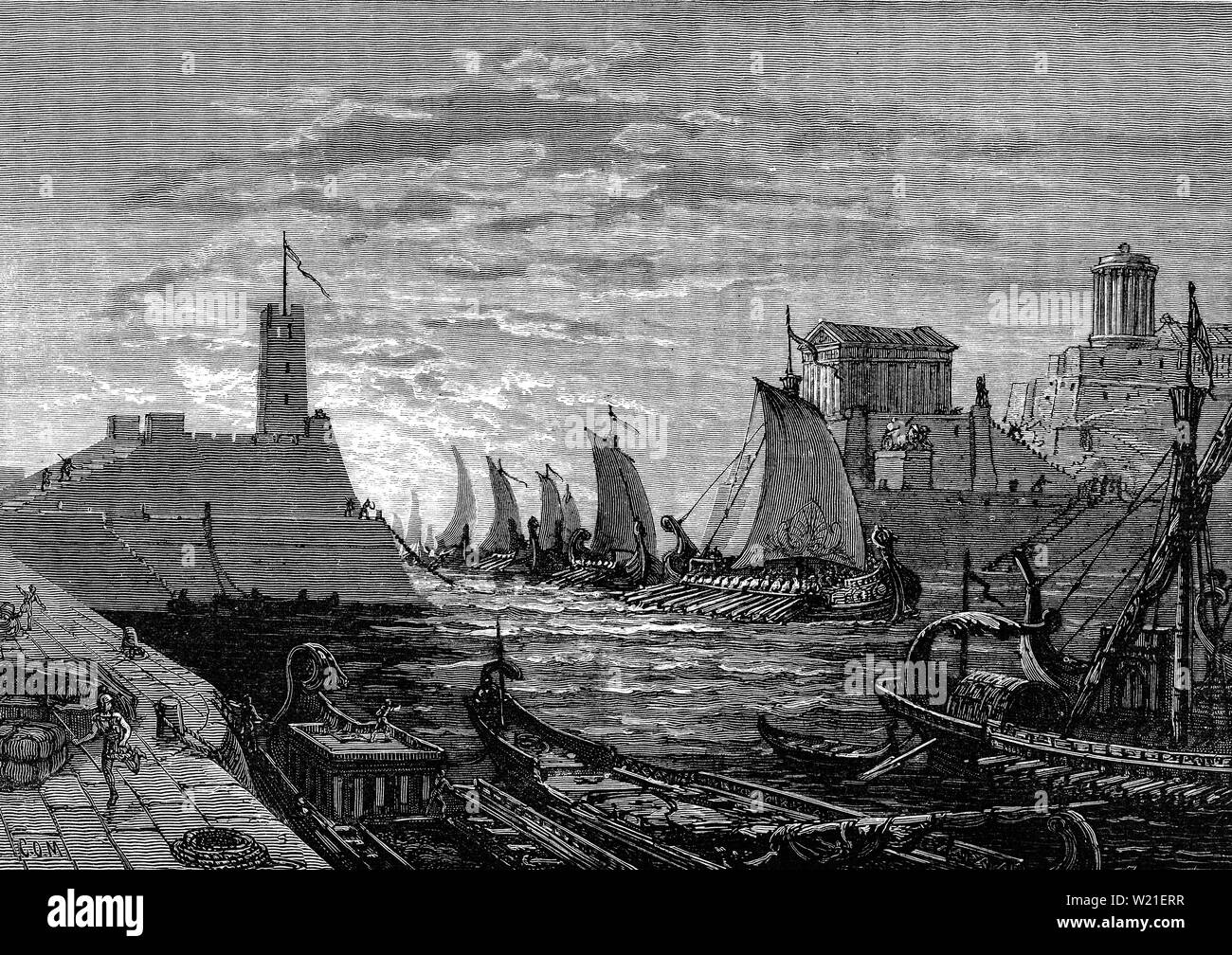 Teleutias (brother of the Spartan king Agesilaus II) was a Spartan naval commander in the Corinthian War who took command of a Spartan fleet to attack Rhodes. He returned to Sparta to great acclaim, and took command of a fleet on the island of Aegina circa 389 BC. The Spartans had suffered several defeats there and the Athenians had relaxed their vigilance in the area. Teleutias took advantage of this fact to launch a raid on Piraeus, the harbor of Athens, where he seized a number of merchant ships and fishing vessels. Stock Photohttps://www.alamy.com/image-license-details/?v=1https://www.alamy.com/teleutias-brother-of-the-spartan-king-agesilaus-ii-was-a-spartan-naval-commander-in-the-corinthian-war-who-took-command-of-a-spartan-fleet-to-attack-rhodes-he-returned-to-sparta-to-great-acclaim-and-took-command-of-a-fleet-on-the-island-of-aegina-circa-389-bc-the-spartans-had-suffered-several-defeats-there-and-the-athenians-had-relaxed-their-vigilance-in-the-area-teleutias-took-advantage-of-this-fact-to-launch-a-raid-on-piraeus-the-harbor-of-athens-where-he-seized-a-number-of-merchant-ships-and-fishing-vessels-image259418427.html
Teleutias (brother of the Spartan king Agesilaus II) was a Spartan naval commander in the Corinthian War who took command of a Spartan fleet to attack Rhodes. He returned to Sparta to great acclaim, and took command of a fleet on the island of Aegina circa 389 BC. The Spartans had suffered several defeats there and the Athenians had relaxed their vigilance in the area. Teleutias took advantage of this fact to launch a raid on Piraeus, the harbor of Athens, where he seized a number of merchant ships and fishing vessels. Stock Photohttps://www.alamy.com/image-license-details/?v=1https://www.alamy.com/teleutias-brother-of-the-spartan-king-agesilaus-ii-was-a-spartan-naval-commander-in-the-corinthian-war-who-took-command-of-a-spartan-fleet-to-attack-rhodes-he-returned-to-sparta-to-great-acclaim-and-took-command-of-a-fleet-on-the-island-of-aegina-circa-389-bc-the-spartans-had-suffered-several-defeats-there-and-the-athenians-had-relaxed-their-vigilance-in-the-area-teleutias-took-advantage-of-this-fact-to-launch-a-raid-on-piraeus-the-harbor-of-athens-where-he-seized-a-number-of-merchant-ships-and-fishing-vessels-image259418427.htmlRMW21ERR–Teleutias (brother of the Spartan king Agesilaus II) was a Spartan naval commander in the Corinthian War who took command of a Spartan fleet to attack Rhodes. He returned to Sparta to great acclaim, and took command of a fleet on the island of Aegina circa 389 BC. The Spartans had suffered several defeats there and the Athenians had relaxed their vigilance in the area. Teleutias took advantage of this fact to launch a raid on Piraeus, the harbor of Athens, where he seized a number of merchant ships and fishing vessels.
 1916 Landing huge gun quay Greek port weapon dock artillery howitzer sailor gunner engineers warehouse ship cargo ship Stock Photohttps://www.alamy.com/image-license-details/?v=1https://www.alamy.com/stock-photo-1916-landing-huge-gun-quay-greek-port-weapon-dock-artillery-howitzer-42023039.html
1916 Landing huge gun quay Greek port weapon dock artillery howitzer sailor gunner engineers warehouse ship cargo ship Stock Photohttps://www.alamy.com/image-license-details/?v=1https://www.alamy.com/stock-photo-1916-landing-huge-gun-quay-greek-port-weapon-dock-artillery-howitzer-42023039.htmlRMCCA8PR–1916 Landing huge gun quay Greek port weapon dock artillery howitzer sailor gunner engineers warehouse ship cargo ship
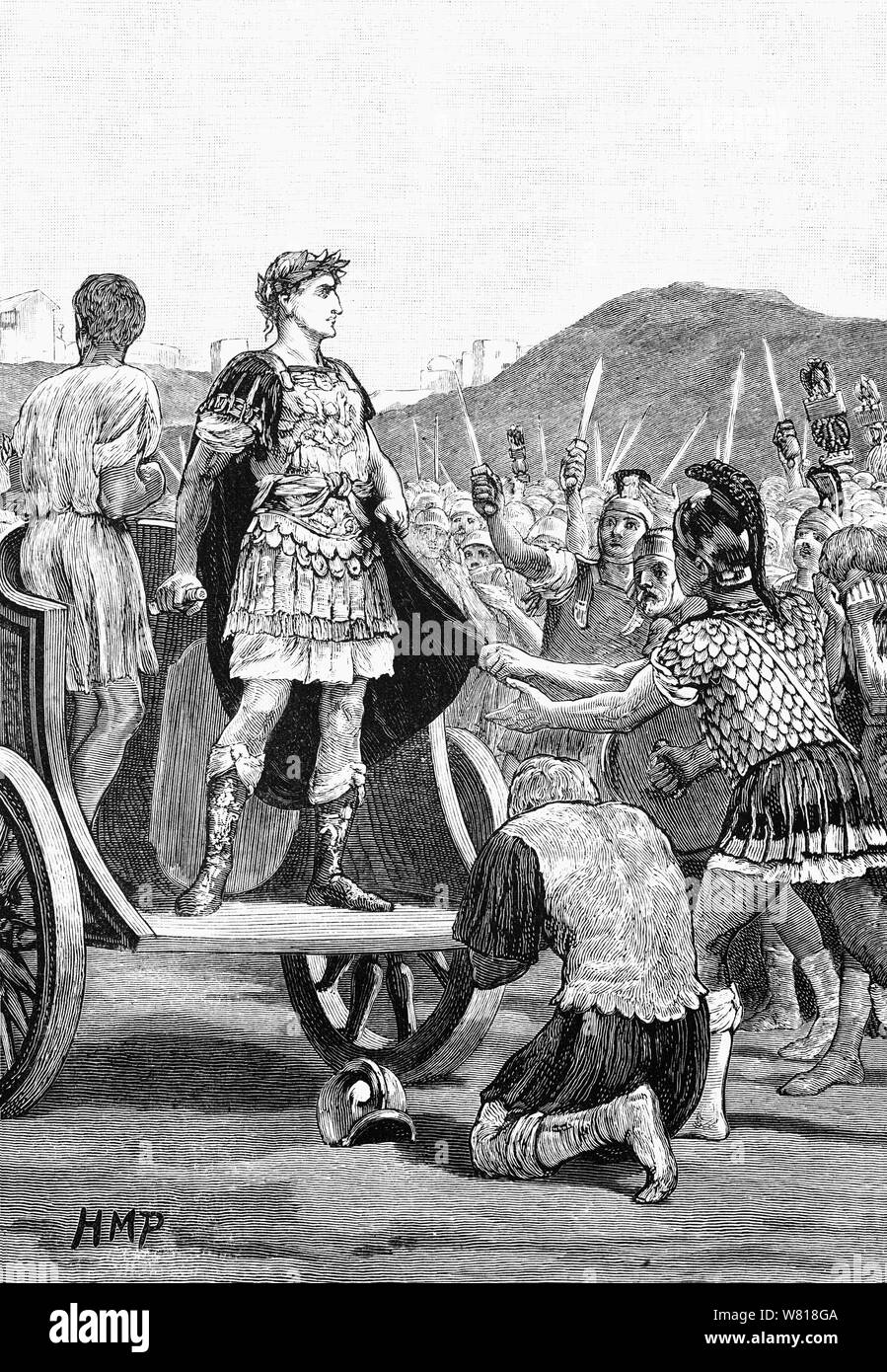 Julius Caesar addressing the malcontent legions in the Campus Martius. Julius Caesar had just returned from crushing the followers of his great rival, Pompey the Great. The people of Rome threw a party in 46 BCE that featured a naval battle on a man-made lake built in the Campus Martius filled with water from the nearby Tiber River. There, two fleets of biremes, triremes, and quadriremes with 4,000 galley slaves and 2,000 crew members on board clashed in a full-scale reconstruction of a naval battle known as the naumachia—from the Greek word for naval battle. Stock Photohttps://www.alamy.com/image-license-details/?v=1https://www.alamy.com/julius-caesar-addressing-the-malcontent-legions-in-the-campus-martius-julius-caesar-had-just-returned-from-crushing-the-followers-of-his-great-rival-pompey-the-great-the-people-of-rome-threw-a-party-in-46-bce-that-featured-a-naval-battle-on-a-man-made-lake-built-in-the-campus-martius-filled-with-water-from-the-nearby-tiber-river-there-two-fleets-of-biremes-triremes-and-quadriremes-with-4000-galley-slaves-and-2000-crew-members-on-board-clashed-in-a-full-scale-reconstruction-of-a-naval-battle-known-as-the-naumachiafrom-the-greek-word-for-naval-battle-image263101450.html
Julius Caesar addressing the malcontent legions in the Campus Martius. Julius Caesar had just returned from crushing the followers of his great rival, Pompey the Great. The people of Rome threw a party in 46 BCE that featured a naval battle on a man-made lake built in the Campus Martius filled with water from the nearby Tiber River. There, two fleets of biremes, triremes, and quadriremes with 4,000 galley slaves and 2,000 crew members on board clashed in a full-scale reconstruction of a naval battle known as the naumachia—from the Greek word for naval battle. Stock Photohttps://www.alamy.com/image-license-details/?v=1https://www.alamy.com/julius-caesar-addressing-the-malcontent-legions-in-the-campus-martius-julius-caesar-had-just-returned-from-crushing-the-followers-of-his-great-rival-pompey-the-great-the-people-of-rome-threw-a-party-in-46-bce-that-featured-a-naval-battle-on-a-man-made-lake-built-in-the-campus-martius-filled-with-water-from-the-nearby-tiber-river-there-two-fleets-of-biremes-triremes-and-quadriremes-with-4000-galley-slaves-and-2000-crew-members-on-board-clashed-in-a-full-scale-reconstruction-of-a-naval-battle-known-as-the-naumachiafrom-the-greek-word-for-naval-battle-image263101450.htmlRMW818GA–Julius Caesar addressing the malcontent legions in the Campus Martius. Julius Caesar had just returned from crushing the followers of his great rival, Pompey the Great. The people of Rome threw a party in 46 BCE that featured a naval battle on a man-made lake built in the Campus Martius filled with water from the nearby Tiber River. There, two fleets of biremes, triremes, and quadriremes with 4,000 galley slaves and 2,000 crew members on board clashed in a full-scale reconstruction of a naval battle known as the naumachia—from the Greek word for naval battle.
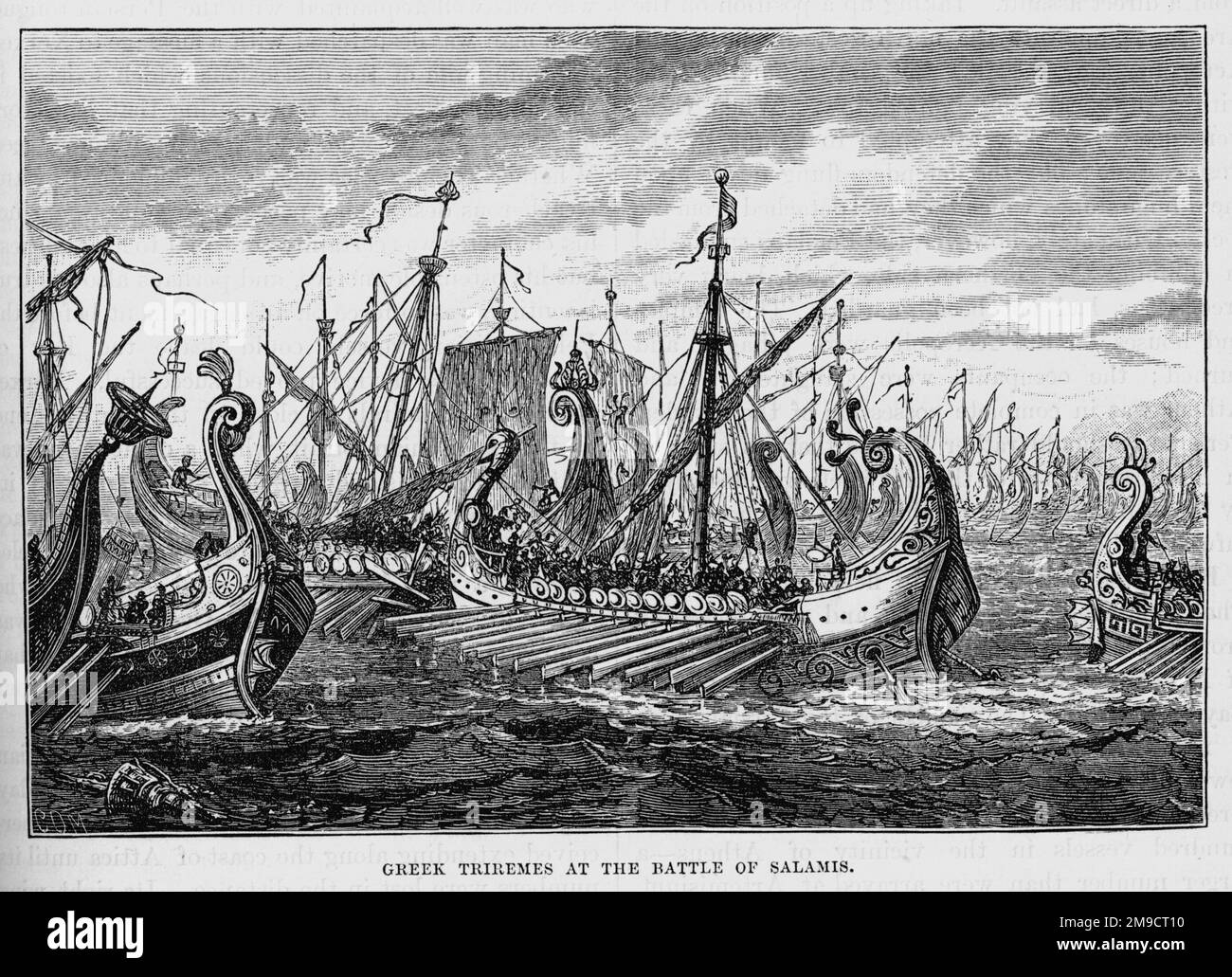 Greek Triremes At Battle Of Salamis during the Second Persian Invasion of Greece Stock Photohttps://www.alamy.com/image-license-details/?v=1https://www.alamy.com/greek-triremes-at-battle-of-salamis-during-the-second-persian-invasion-of-greece-image504914844.html
Greek Triremes At Battle Of Salamis during the Second Persian Invasion of Greece Stock Photohttps://www.alamy.com/image-license-details/?v=1https://www.alamy.com/greek-triremes-at-battle-of-salamis-during-the-second-persian-invasion-of-greece-image504914844.htmlRM2M9CT10–Greek Triremes At Battle Of Salamis during the Second Persian Invasion of Greece
 Lysander was a Spartan admiral who commanded the Spartan fleet in the Hellespont which defeated the Athenians at Aegospotami in 405 BC. Following the victory the Spartans required the Athenians to raze the walls of Piraeus along with the Long Walls which connected Athens and Piraeus. Stock Photohttps://www.alamy.com/image-license-details/?v=1https://www.alamy.com/stock-photo-lysander-was-a-spartan-admiral-who-commanded-the-spartan-fleet-in-148188493.html
Lysander was a Spartan admiral who commanded the Spartan fleet in the Hellespont which defeated the Athenians at Aegospotami in 405 BC. Following the victory the Spartans required the Athenians to raze the walls of Piraeus along with the Long Walls which connected Athens and Piraeus. Stock Photohttps://www.alamy.com/image-license-details/?v=1https://www.alamy.com/stock-photo-lysander-was-a-spartan-admiral-who-commanded-the-spartan-fleet-in-148188493.htmlRMJH2FX5–Lysander was a Spartan admiral who commanded the Spartan fleet in the Hellespont which defeated the Athenians at Aegospotami in 405 BC. Following the victory the Spartans required the Athenians to raze the walls of Piraeus along with the Long Walls which connected Athens and Piraeus.
![Battle-scarred Greek warship at Southampton for Coronation review. The Greek battle-cruiser which is to take part in the Coronation naval review at Spithead, docked at Southampton. She survived intense aerial bombardment during the Greek revolution two years ago. Photo shows: Averoff [Georgios Averof] docking at Southampton. 7 May 1937 Stock Photo Battle-scarred Greek warship at Southampton for Coronation review. The Greek battle-cruiser which is to take part in the Coronation naval review at Spithead, docked at Southampton. She survived intense aerial bombardment during the Greek revolution two years ago. Photo shows: Averoff [Georgios Averof] docking at Southampton. 7 May 1937 Stock Photo](https://c8.alamy.com/comp/2BW1XNR/battle-scarred-greek-warship-at-southampton-for-coronation-review-the-greek-battle-cruiser-which-is-to-take-part-in-the-coronation-naval-review-at-spithead-docked-at-southampton-she-survived-intense-aerial-bombardment-during-the-greek-revolution-two-years-ago-photo-shows-averoff-georgios-averof-docking-at-southampton-7-may-1937-2BW1XNR.jpg) Battle-scarred Greek warship at Southampton for Coronation review. The Greek battle-cruiser which is to take part in the Coronation naval review at Spithead, docked at Southampton. She survived intense aerial bombardment during the Greek revolution two years ago. Photo shows: Averoff [Georgios Averof] docking at Southampton. 7 May 1937 Stock Photohttps://www.alamy.com/image-license-details/?v=1https://www.alamy.com/battle-scarred-greek-warship-at-southampton-for-coronation-review-the-greek-battle-cruiser-which-is-to-take-part-in-the-coronation-naval-review-at-spithead-docked-at-southampton-she-survived-intense-aerial-bombardment-during-the-greek-revolution-two-years-ago-photo-shows-averoff-georgios-averof-docking-at-southampton-7-may-1937-image359616707.html
Battle-scarred Greek warship at Southampton for Coronation review. The Greek battle-cruiser which is to take part in the Coronation naval review at Spithead, docked at Southampton. She survived intense aerial bombardment during the Greek revolution two years ago. Photo shows: Averoff [Georgios Averof] docking at Southampton. 7 May 1937 Stock Photohttps://www.alamy.com/image-license-details/?v=1https://www.alamy.com/battle-scarred-greek-warship-at-southampton-for-coronation-review-the-greek-battle-cruiser-which-is-to-take-part-in-the-coronation-naval-review-at-spithead-docked-at-southampton-she-survived-intense-aerial-bombardment-during-the-greek-revolution-two-years-ago-photo-shows-averoff-georgios-averof-docking-at-southampton-7-may-1937-image359616707.htmlRM2BW1XNR–Battle-scarred Greek warship at Southampton for Coronation review. The Greek battle-cruiser which is to take part in the Coronation naval review at Spithead, docked at Southampton. She survived intense aerial bombardment during the Greek revolution two years ago. Photo shows: Averoff [Georgios Averof] docking at Southampton. 7 May 1937
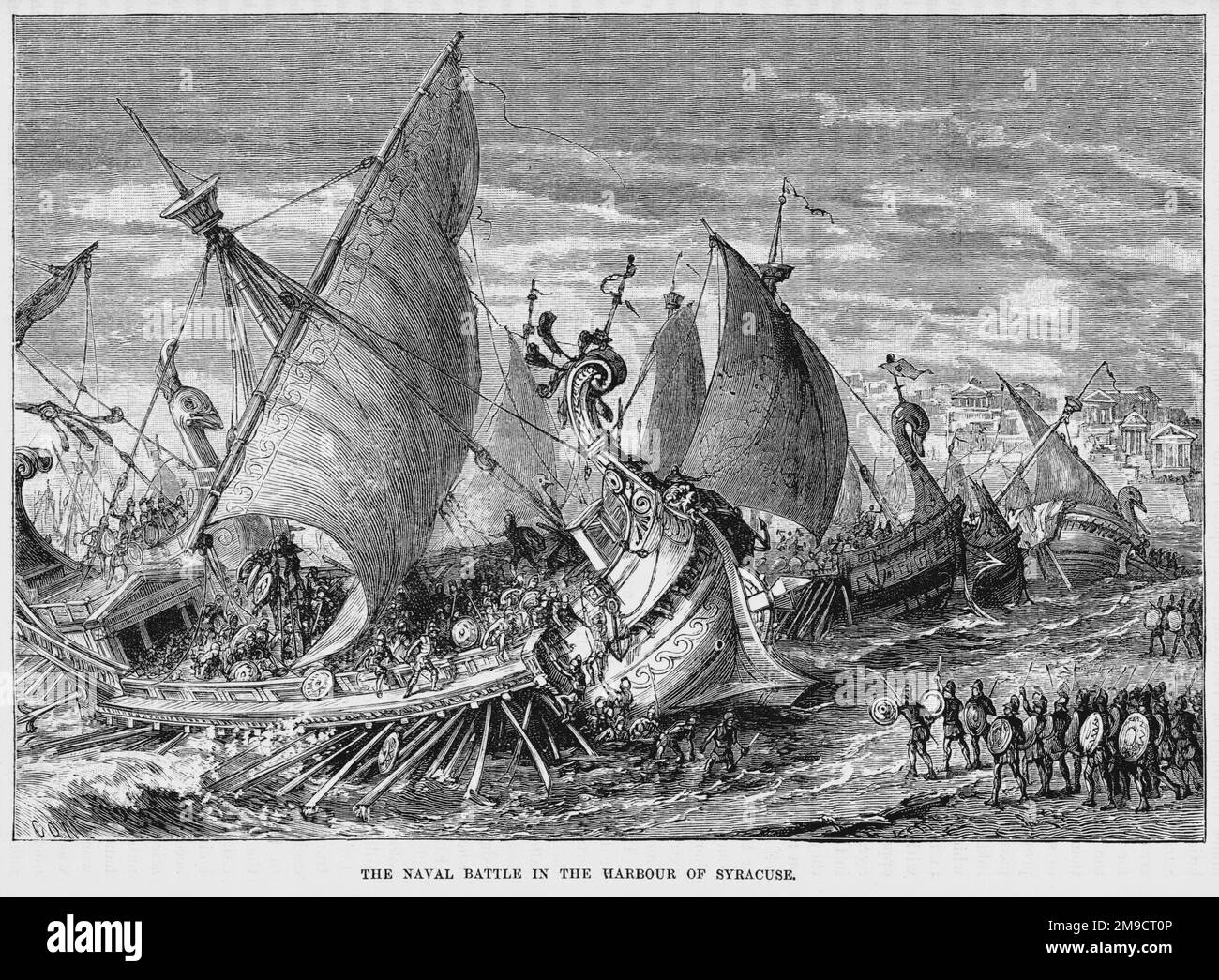 Naval Battle In Harbour Of Syracuse, 416 Bc Stock Photohttps://www.alamy.com/image-license-details/?v=1https://www.alamy.com/naval-battle-in-harbour-of-syracuse-416-bc-image504914838.html
Naval Battle In Harbour Of Syracuse, 416 Bc Stock Photohttps://www.alamy.com/image-license-details/?v=1https://www.alamy.com/naval-battle-in-harbour-of-syracuse-416-bc-image504914838.htmlRM2M9CT0P–Naval Battle In Harbour Of Syracuse, 416 Bc
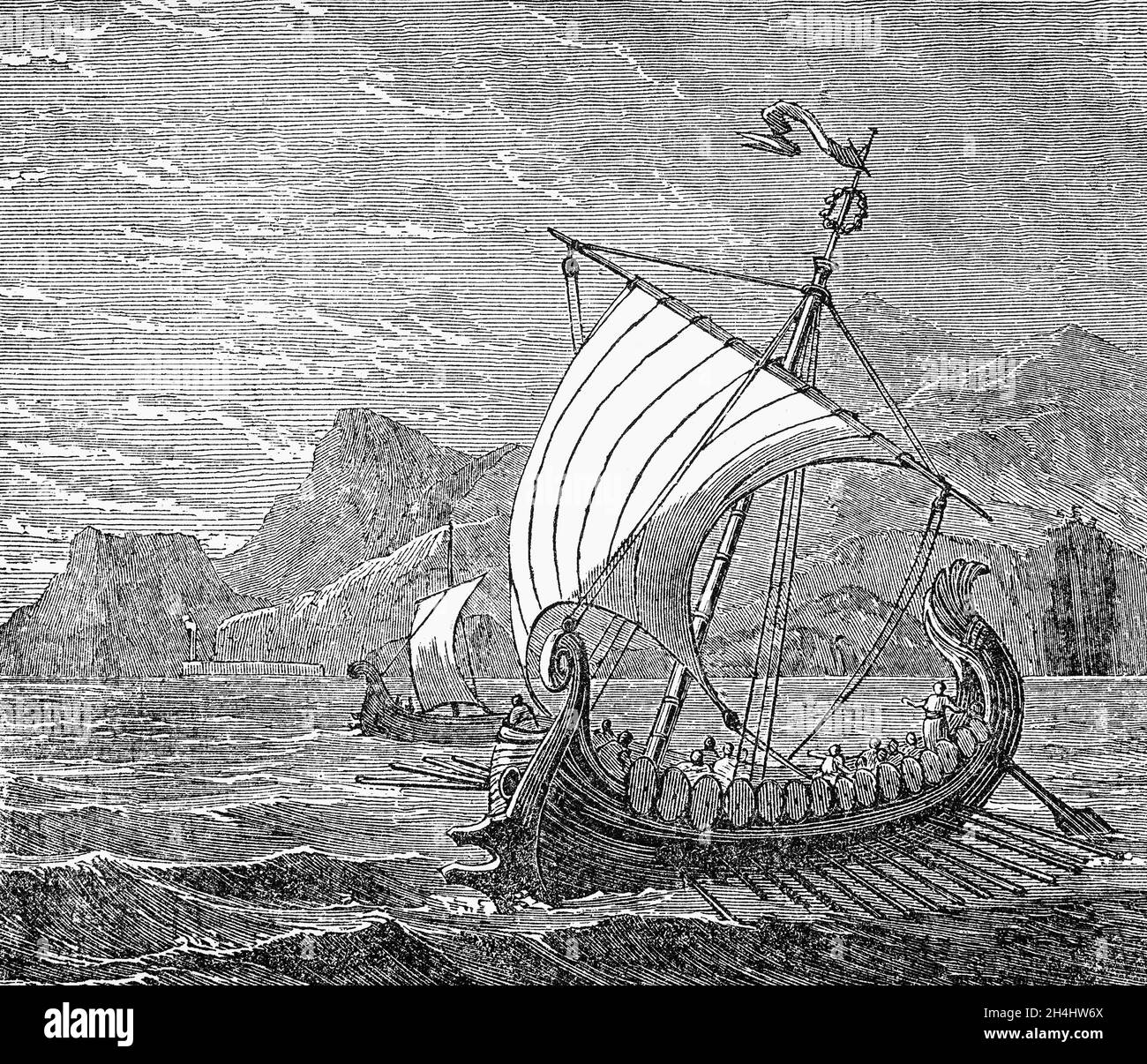 A late 19th Century illustration of a Roman Galley, a type of ship that is propelled mainly by oars and/ or sails. They have been around so long their exact origin remains unknown. By the time naval warfare was being recorded, they allowed naval powers to dominate the Mediterranean world. Galleys went on to play a huge part in the battle for the Mediterranean between the Romans and Carthaginians in the 3rd and 2nd centuries BC – the Punic Wars. Stock Photohttps://www.alamy.com/image-license-details/?v=1https://www.alamy.com/a-late-19th-century-illustration-of-a-roman-galley-a-type-of-ship-that-is-propelled-mainly-by-oars-and-or-sails-they-have-been-around-so-long-their-exact-origin-remains-unknown-by-the-time-naval-warfare-was-being-recorded-they-allowed-naval-powers-to-dominate-the-mediterranean-world-galleys-went-on-to-play-a-huge-part-in-the-battle-for-the-mediterranean-between-the-romans-and-carthaginians-in-the-3rd-and-2nd-centuries-bc-the-punic-wars-image450321170.html
A late 19th Century illustration of a Roman Galley, a type of ship that is propelled mainly by oars and/ or sails. They have been around so long their exact origin remains unknown. By the time naval warfare was being recorded, they allowed naval powers to dominate the Mediterranean world. Galleys went on to play a huge part in the battle for the Mediterranean between the Romans and Carthaginians in the 3rd and 2nd centuries BC – the Punic Wars. Stock Photohttps://www.alamy.com/image-license-details/?v=1https://www.alamy.com/a-late-19th-century-illustration-of-a-roman-galley-a-type-of-ship-that-is-propelled-mainly-by-oars-and-or-sails-they-have-been-around-so-long-their-exact-origin-remains-unknown-by-the-time-naval-warfare-was-being-recorded-they-allowed-naval-powers-to-dominate-the-mediterranean-world-galleys-went-on-to-play-a-huge-part-in-the-battle-for-the-mediterranean-between-the-romans-and-carthaginians-in-the-3rd-and-2nd-centuries-bc-the-punic-wars-image450321170.htmlRM2H4HW6X–A late 19th Century illustration of a Roman Galley, a type of ship that is propelled mainly by oars and/ or sails. They have been around so long their exact origin remains unknown. By the time naval warfare was being recorded, they allowed naval powers to dominate the Mediterranean world. Galleys went on to play a huge part in the battle for the Mediterranean between the Romans and Carthaginians in the 3rd and 2nd centuries BC – the Punic Wars.
 The three British Royal Naval warships which played the leading role in the Battle of Cape Matapan, off the coast of the Greek Peloponnesian peninsula. In the foreground, firing a broadside, is H.M.S.Valiant, and behind are H.M.S. Barham and Warspite. The naval engagement resulted in the loss and severe damage of several Italian warships. Date: 27 - 29 March 1941 Stock Photohttps://www.alamy.com/image-license-details/?v=1https://www.alamy.com/the-three-british-royal-naval-warships-which-played-the-leading-role-in-the-battle-of-cape-matapan-off-the-coast-of-the-greek-peloponnesian-peninsula-in-the-foreground-firing-a-broadside-is-hmsvaliant-and-behind-are-hms-barham-and-warspite-the-naval-engagement-resulted-in-the-loss-and-severe-damage-of-several-italian-warships-date-27-29-march-1941-image501436861.html
The three British Royal Naval warships which played the leading role in the Battle of Cape Matapan, off the coast of the Greek Peloponnesian peninsula. In the foreground, firing a broadside, is H.M.S.Valiant, and behind are H.M.S. Barham and Warspite. The naval engagement resulted in the loss and severe damage of several Italian warships. Date: 27 - 29 March 1941 Stock Photohttps://www.alamy.com/image-license-details/?v=1https://www.alamy.com/the-three-british-royal-naval-warships-which-played-the-leading-role-in-the-battle-of-cape-matapan-off-the-coast-of-the-greek-peloponnesian-peninsula-in-the-foreground-firing-a-broadside-is-hmsvaliant-and-behind-are-hms-barham-and-warspite-the-naval-engagement-resulted-in-the-loss-and-severe-damage-of-several-italian-warships-date-27-29-march-1941-image501436861.htmlRM2M3PBR9–The three British Royal Naval warships which played the leading role in the Battle of Cape Matapan, off the coast of the Greek Peloponnesian peninsula. In the foreground, firing a broadside, is H.M.S.Valiant, and behind are H.M.S. Barham and Warspite. The naval engagement resulted in the loss and severe damage of several Italian warships. Date: 27 - 29 March 1941
RF2Y85WC7–Ancient Greek ship icon
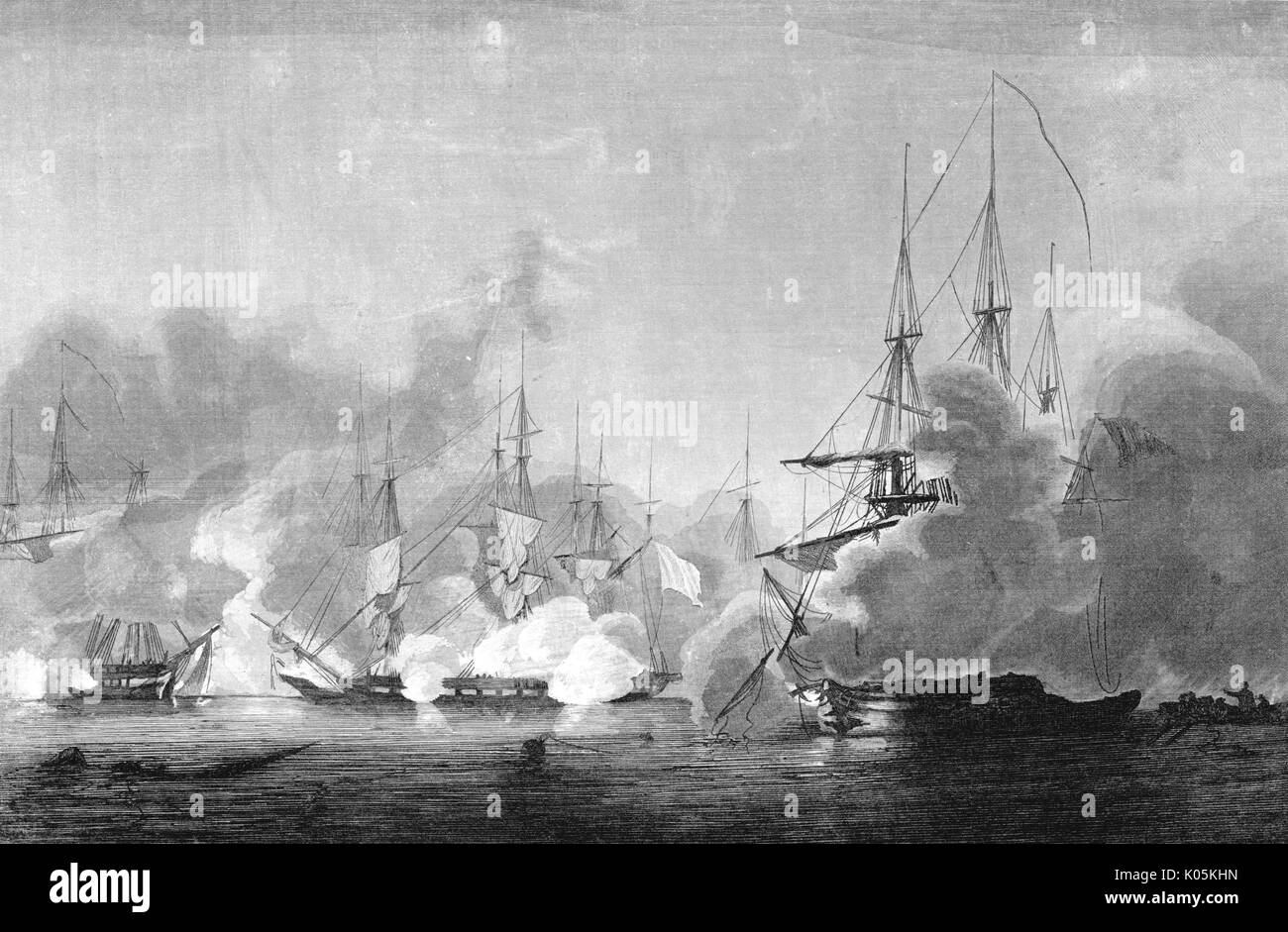 BATTLE OF NAVARINO 1827 Stock Photohttps://www.alamy.com/image-license-details/?v=1https://www.alamy.com/battle-of-navarino-1827-image155018465.html
BATTLE OF NAVARINO 1827 Stock Photohttps://www.alamy.com/image-license-details/?v=1https://www.alamy.com/battle-of-navarino-1827-image155018465.htmlRMK05KHN–BATTLE OF NAVARINO 1827
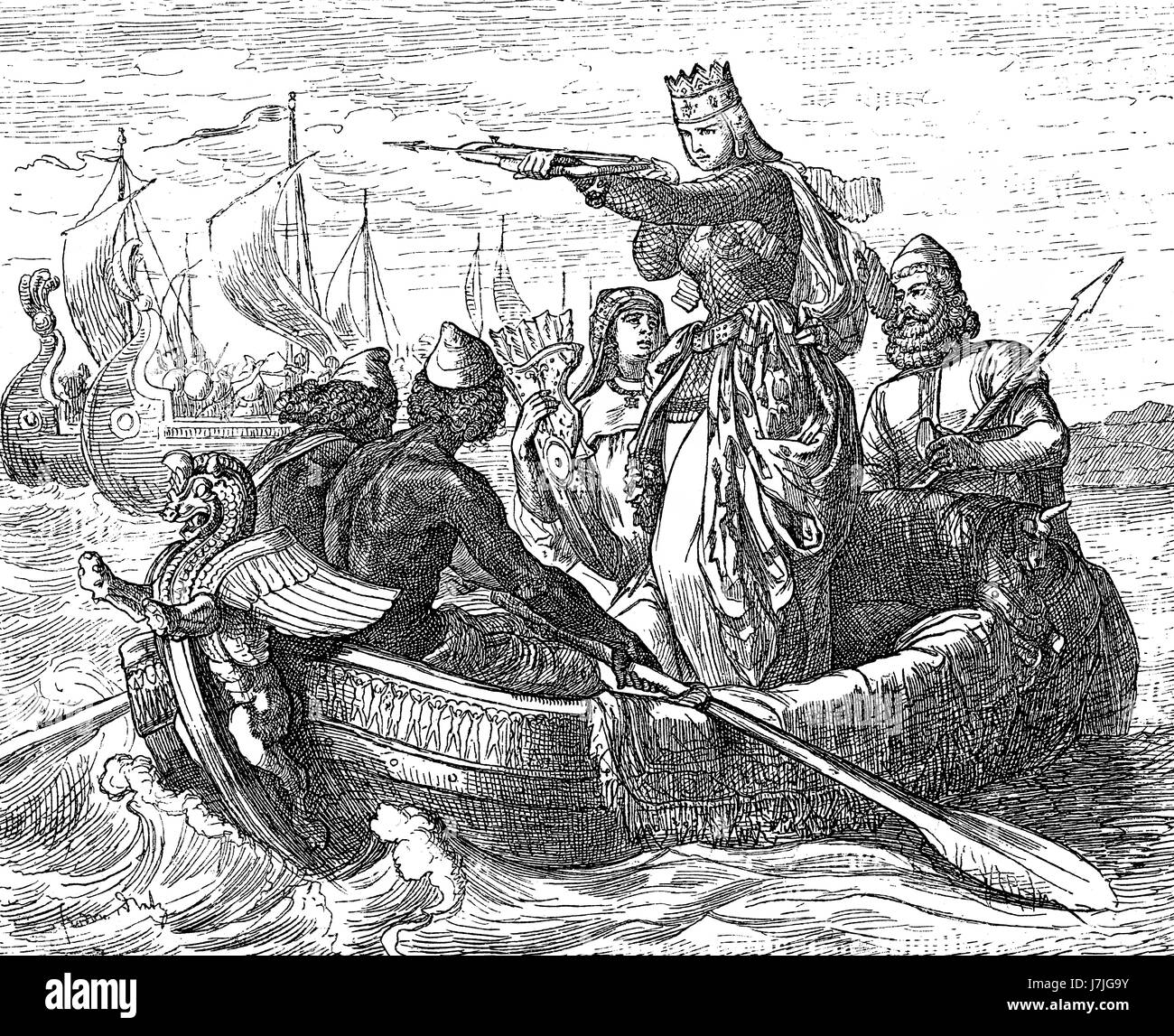 Artemisia I of Caria, a Greek queen of the ancient Greek city-state of Halicarnassus Stock Photohttps://www.alamy.com/image-license-details/?v=1https://www.alamy.com/stock-photo-artemisia-i-of-caria-a-greek-queen-of-the-ancient-greek-city-state-142393495.html
Artemisia I of Caria, a Greek queen of the ancient Greek city-state of Halicarnassus Stock Photohttps://www.alamy.com/image-license-details/?v=1https://www.alamy.com/stock-photo-artemisia-i-of-caria-a-greek-queen-of-the-ancient-greek-city-state-142393495.htmlRMJ7JG9Y–Artemisia I of Caria, a Greek queen of the ancient Greek city-state of Halicarnassus
 Greeks Return from Battle of Salamis, 480 BC Stock Photohttps://www.alamy.com/image-license-details/?v=1https://www.alamy.com/greeks-return-from-battle-of-salamis-480-bc-image416792074.html
Greeks Return from Battle of Salamis, 480 BC Stock Photohttps://www.alamy.com/image-license-details/?v=1https://www.alamy.com/greeks-return-from-battle-of-salamis-480-bc-image416792074.htmlRM2F62EF6–Greeks Return from Battle of Salamis, 480 BC
 The Athenian fleet attacking Syracuse in Sicily, 415 BC, Peloponnesian War Stock Photohttps://www.alamy.com/image-license-details/?v=1https://www.alamy.com/stock-photo-the-athenian-fleet-attacking-syracuse-in-sicily-415-bc-peloponnesian-143680912.html
The Athenian fleet attacking Syracuse in Sicily, 415 BC, Peloponnesian War Stock Photohttps://www.alamy.com/image-license-details/?v=1https://www.alamy.com/stock-photo-the-athenian-fleet-attacking-syracuse-in-sicily-415-bc-peloponnesian-143680912.htmlRMJ9N6D4–The Athenian fleet attacking Syracuse in Sicily, 415 BC, Peloponnesian War
 Defeat of Xerxes at Salamis Stock Photohttps://www.alamy.com/image-license-details/?v=1https://www.alamy.com/stock-photo-defeat-of-xerxes-at-salamis-21281283.html
Defeat of Xerxes at Salamis Stock Photohttps://www.alamy.com/image-license-details/?v=1https://www.alamy.com/stock-photo-defeat-of-xerxes-at-salamis-21281283.htmlRFB6HCDR–Defeat of Xerxes at Salamis
 Aeschylus and Sophokles, dancing after the the Battle of Salamis in 480 BC Stock Photohttps://www.alamy.com/image-license-details/?v=1https://www.alamy.com/stock-photo-aeschylus-and-sophokles-dancing-after-the-the-battle-of-salamis-in-142393553.html
Aeschylus and Sophokles, dancing after the the Battle of Salamis in 480 BC Stock Photohttps://www.alamy.com/image-license-details/?v=1https://www.alamy.com/stock-photo-aeschylus-and-sophokles-dancing-after-the-the-battle-of-salamis-in-142393553.htmlRMJ7JGC1–Aeschylus and Sophokles, dancing after the the Battle of Salamis in 480 BC
 Map of the Battle of Actium on 2 September 31 BC, Ionian Sea, Greece Stock Photohttps://www.alamy.com/image-license-details/?v=1https://www.alamy.com/map-of-the-battle-of-actium-on-2-september-31-bc-ionian-sea-greece-image366611937.html
Map of the Battle of Actium on 2 September 31 BC, Ionian Sea, Greece Stock Photohttps://www.alamy.com/image-license-details/?v=1https://www.alamy.com/map-of-the-battle-of-actium-on-2-september-31-bc-ionian-sea-greece-image366611937.htmlRM2C8CH7D–Map of the Battle of Actium on 2 September 31 BC, Ionian Sea, Greece
 'Battle of Navarino', c1880. Artist: C.R.. Stock Photohttps://www.alamy.com/image-license-details/?v=1https://www.alamy.com/battle-of-navarino-c1880-artist-cr-image186143283.html
'Battle of Navarino', c1880. Artist: C.R.. Stock Photohttps://www.alamy.com/image-license-details/?v=1https://www.alamy.com/battle-of-navarino-c1880-artist-cr-image186143283.htmlRMMPRFJB–'Battle of Navarino', c1880. Artist: C.R..
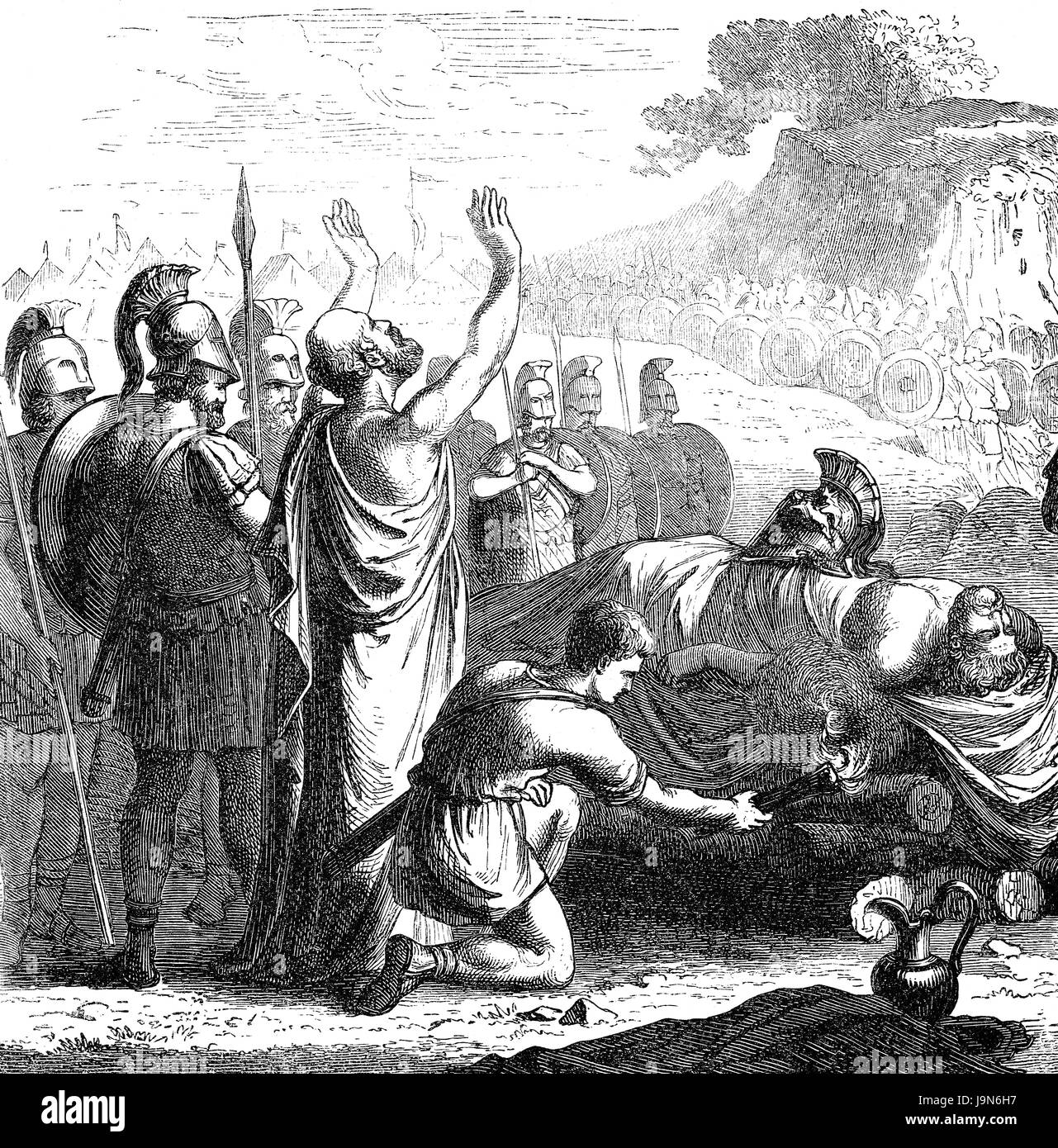 The funeral banquet after the First Battle of Coronea in 447 BC, First Peloponnesian War Stock Photohttps://www.alamy.com/image-license-details/?v=1https://www.alamy.com/stock-photo-the-funeral-banquet-after-the-first-battle-of-coronea-in-447-bc-first-143681027.html
The funeral banquet after the First Battle of Coronea in 447 BC, First Peloponnesian War Stock Photohttps://www.alamy.com/image-license-details/?v=1https://www.alamy.com/stock-photo-the-funeral-banquet-after-the-first-battle-of-coronea-in-447-bc-first-143681027.htmlRMJ9N6H7–The funeral banquet after the First Battle of Coronea in 447 BC, First Peloponnesian War
 BATTLE OF NAVARINO/1827 Stock Photohttps://www.alamy.com/image-license-details/?v=1https://www.alamy.com/battle-of-navarino1827-image155018463.html
BATTLE OF NAVARINO/1827 Stock Photohttps://www.alamy.com/image-license-details/?v=1https://www.alamy.com/battle-of-navarino1827-image155018463.htmlRMK05KHK–BATTLE OF NAVARINO/1827
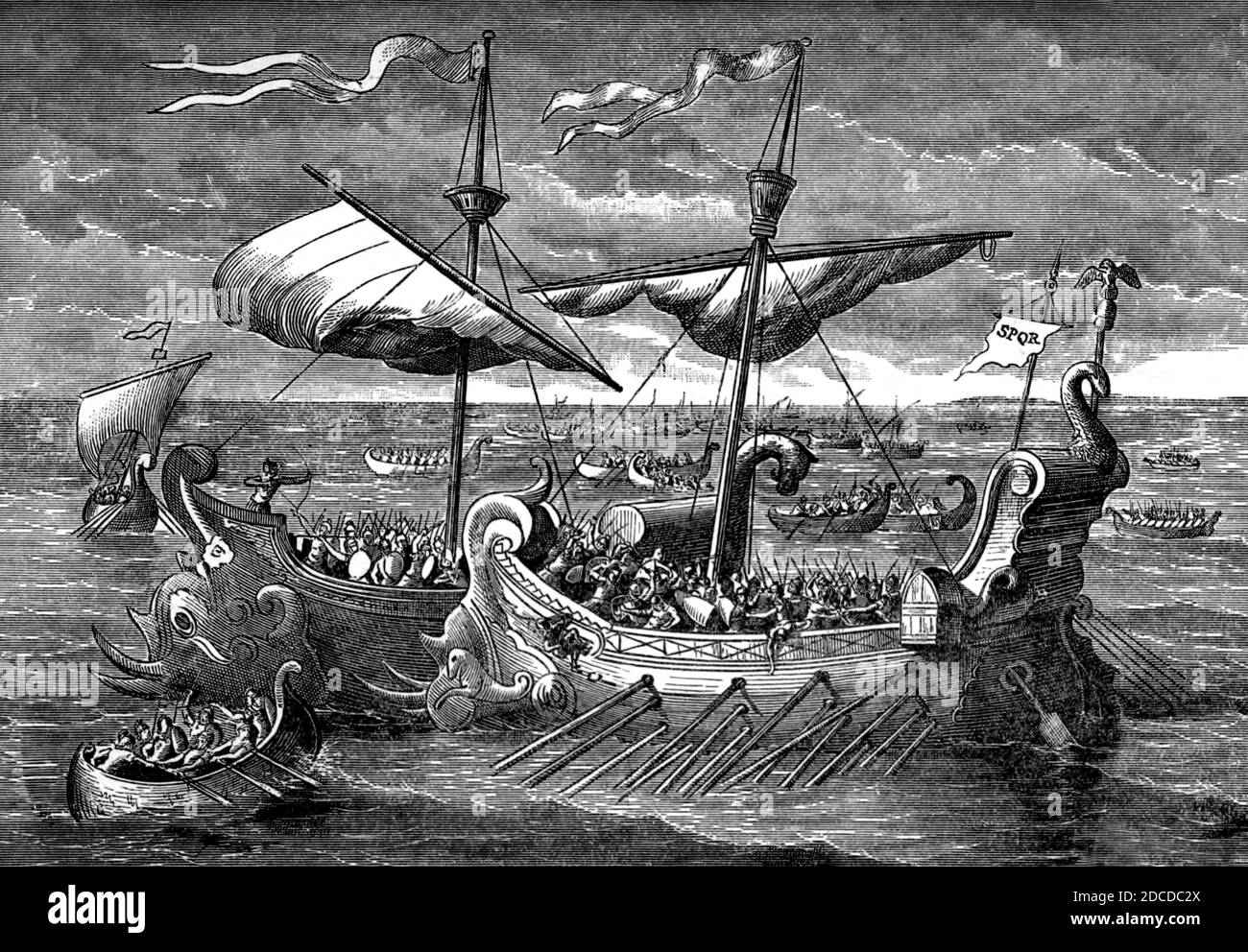 Battle of Actium, 31 BC Stock Photohttps://www.alamy.com/image-license-details/?v=1https://www.alamy.com/battle-of-actium-31-bc-image386298834.html
Battle of Actium, 31 BC Stock Photohttps://www.alamy.com/image-license-details/?v=1https://www.alamy.com/battle-of-actium-31-bc-image386298834.htmlRF2DCDC2X–Battle of Actium, 31 BC
![Balaclava Harbour, 1854. Crimean War. '...Balaclava has been completely changed into a Greek town...[It] is situated close to the harbour, along the foot of the mountain, but it is not provided with good water. As the port is deep, sheltered by lofty mountains, and contracted towards the sea, its waters are in general as calm as those of a pond. The length of the harbour does not exceed one verst and a half, and its breadth is about 200 fathoms. The entrance is very deep; yet being confined within high rocks its channel scarcely admits two vessels to sail abreast...The old fortress, like all t Stock Photo Balaclava Harbour, 1854. Crimean War. '...Balaclava has been completely changed into a Greek town...[It] is situated close to the harbour, along the foot of the mountain, but it is not provided with good water. As the port is deep, sheltered by lofty mountains, and contracted towards the sea, its waters are in general as calm as those of a pond. The length of the harbour does not exceed one verst and a half, and its breadth is about 200 fathoms. The entrance is very deep; yet being confined within high rocks its channel scarcely admits two vessels to sail abreast...The old fortress, like all t Stock Photo](https://c8.alamy.com/comp/2K040N7/balaclava-harbour-1854-crimean-war-balaclava-has-been-completely-changed-into-a-greek-town-it-is-situated-close-to-the-harbour-along-the-foot-of-the-mountain-but-it-is-not-provided-with-good-water-as-the-port-is-deep-sheltered-by-lofty-mountains-and-contracted-towards-the-sea-its-waters-are-in-general-as-calm-as-those-of-a-pond-the-length-of-the-harbour-does-not-exceed-one-verst-and-a-half-and-its-breadth-is-about-200-fathoms-the-entrance-is-very-deep-yet-being-confined-within-high-rocks-its-channel-scarcely-admits-two-vessels-to-sail-abreastthe-old-fortress-like-all-t-2K040N7.jpg) Balaclava Harbour, 1854. Crimean War. '...Balaclava has been completely changed into a Greek town...[It] is situated close to the harbour, along the foot of the mountain, but it is not provided with good water. As the port is deep, sheltered by lofty mountains, and contracted towards the sea, its waters are in general as calm as those of a pond. The length of the harbour does not exceed one verst and a half, and its breadth is about 200 fathoms. The entrance is very deep; yet being confined within high rocks its channel scarcely admits two vessels to sail abreast...The old fortress, like all t Stock Photohttps://www.alamy.com/image-license-details/?v=1https://www.alamy.com/balaclava-harbour-1854-crimean-war-balaclava-has-been-completely-changed-into-a-greek-town-it-is-situated-close-to-the-harbour-along-the-foot-of-the-mountain-but-it-is-not-provided-with-good-water-as-the-port-is-deep-sheltered-by-lofty-mountains-and-contracted-towards-the-sea-its-waters-are-in-general-as-calm-as-those-of-a-pond-the-length-of-the-harbour-does-not-exceed-one-verst-and-a-half-and-its-breadth-is-about-200-fathoms-the-entrance-is-very-deep-yet-being-confined-within-high-rocks-its-channel-scarcely-admits-two-vessels-to-sail-abreastthe-old-fortress-like-all-t-image481978707.html
Balaclava Harbour, 1854. Crimean War. '...Balaclava has been completely changed into a Greek town...[It] is situated close to the harbour, along the foot of the mountain, but it is not provided with good water. As the port is deep, sheltered by lofty mountains, and contracted towards the sea, its waters are in general as calm as those of a pond. The length of the harbour does not exceed one verst and a half, and its breadth is about 200 fathoms. The entrance is very deep; yet being confined within high rocks its channel scarcely admits two vessels to sail abreast...The old fortress, like all t Stock Photohttps://www.alamy.com/image-license-details/?v=1https://www.alamy.com/balaclava-harbour-1854-crimean-war-balaclava-has-been-completely-changed-into-a-greek-town-it-is-situated-close-to-the-harbour-along-the-foot-of-the-mountain-but-it-is-not-provided-with-good-water-as-the-port-is-deep-sheltered-by-lofty-mountains-and-contracted-towards-the-sea-its-waters-are-in-general-as-calm-as-those-of-a-pond-the-length-of-the-harbour-does-not-exceed-one-verst-and-a-half-and-its-breadth-is-about-200-fathoms-the-entrance-is-very-deep-yet-being-confined-within-high-rocks-its-channel-scarcely-admits-two-vessels-to-sail-abreastthe-old-fortress-like-all-t-image481978707.htmlRM2K040N7–Balaclava Harbour, 1854. Crimean War. '...Balaclava has been completely changed into a Greek town...[It] is situated close to the harbour, along the foot of the mountain, but it is not provided with good water. As the port is deep, sheltered by lofty mountains, and contracted towards the sea, its waters are in general as calm as those of a pond. The length of the harbour does not exceed one verst and a half, and its breadth is about 200 fathoms. The entrance is very deep; yet being confined within high rocks its channel scarcely admits two vessels to sail abreast...The old fortress, like all t
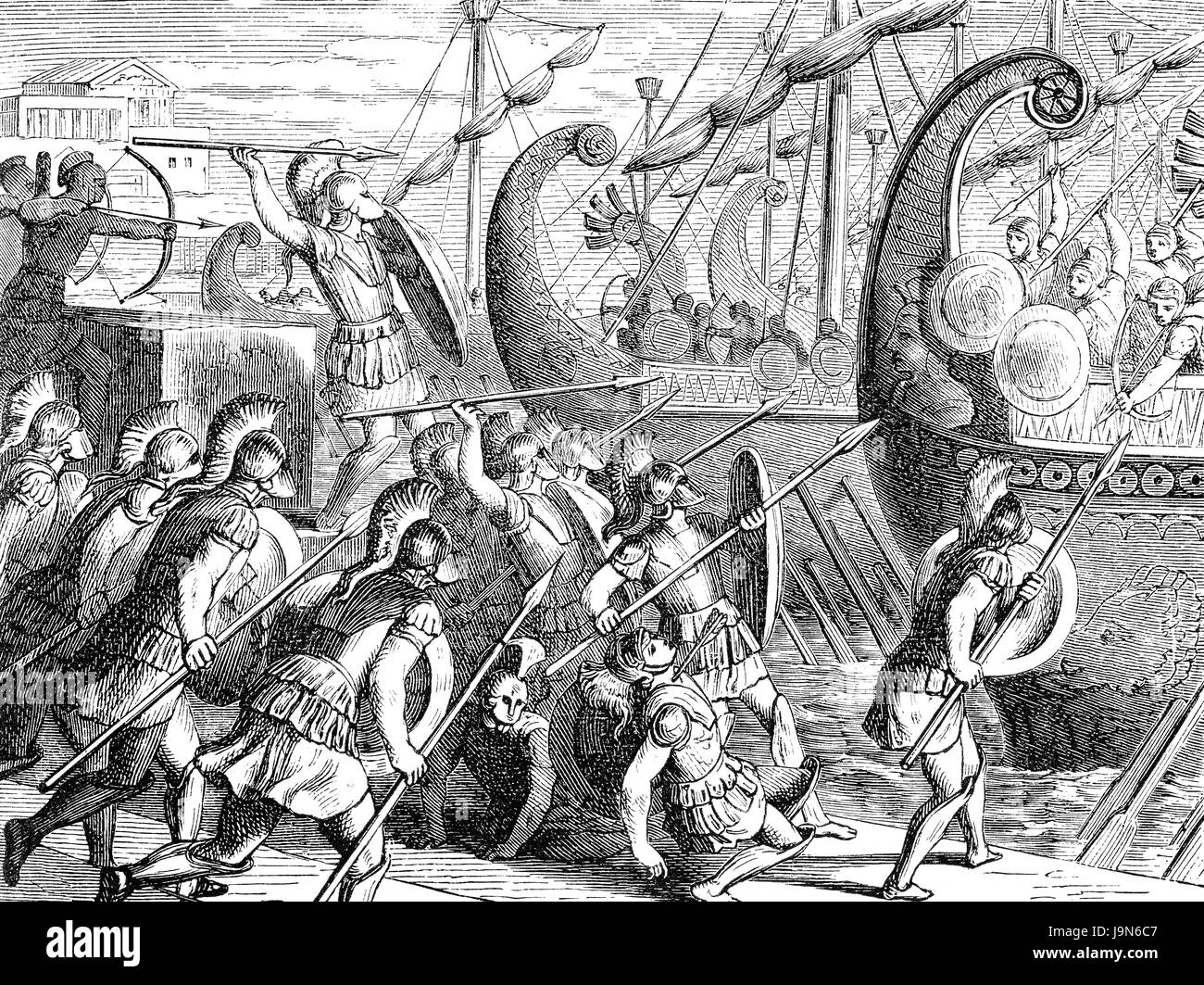 Brasidas, an Spartan officer, defendering the port of Methone or Methoni, while the Athenian fleet attacking, Peloponnesian War Stock Photohttps://www.alamy.com/image-license-details/?v=1https://www.alamy.com/stock-photo-brasidas-an-spartan-officer-defendering-the-port-of-methone-or-methoni-143680887.html
Brasidas, an Spartan officer, defendering the port of Methone or Methoni, while the Athenian fleet attacking, Peloponnesian War Stock Photohttps://www.alamy.com/image-license-details/?v=1https://www.alamy.com/stock-photo-brasidas-an-spartan-officer-defendering-the-port-of-methone-or-methoni-143680887.htmlRMJ9N6C7–Brasidas, an Spartan officer, defendering the port of Methone or Methoni, while the Athenian fleet attacking, Peloponnesian War
 Spartan admiral Teleutias launching a raid on Piraeus in ancient Greece, 389 BC Stock Photohttps://www.alamy.com/image-license-details/?v=1https://www.alamy.com/stock-photo-spartan-admiral-teleutias-launching-a-raid-on-piraeus-in-ancient-greece-145187364.html
Spartan admiral Teleutias launching a raid on Piraeus in ancient Greece, 389 BC Stock Photohttps://www.alamy.com/image-license-details/?v=1https://www.alamy.com/stock-photo-spartan-admiral-teleutias-launching-a-raid-on-piraeus-in-ancient-greece-145187364.htmlRMJC5RY0–Spartan admiral Teleutias launching a raid on Piraeus in ancient Greece, 389 BC
